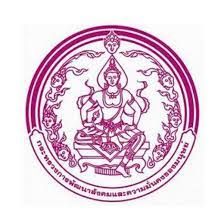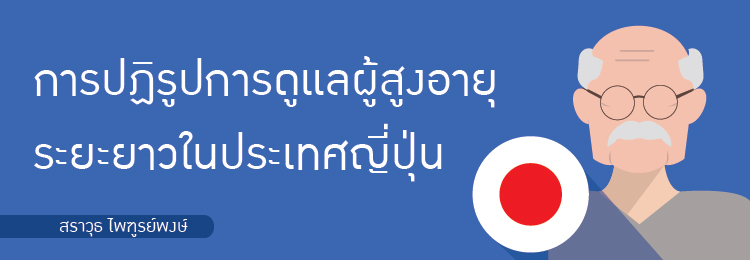สังคมผู้สูงอายุในปัจจุบันและเศรษฐกิจในประเทศไทย

จากคำนิยามเราเข้าใจว่า ‘สังคมสูงวัย’ คือ สังคมที่มีสัดส่วนของผู้สูงอายุหรือประชากรที่มีอายุ 60 ปี ขึ้นไป ได้เพิ่มสูงขึ้นเรื่อยๆ ขณะที่สัดส่วนของอัตราการเกิด และจำนวนประชากรในวัยทำงานลดน้อยลง. ประเทศต่างๆ รอบข้างเราได้มีปัญหาเรื่องนี้แล้ว เช่น ที่สิงคโปร์มีสัดส่วนของผู้สูงอายุใกล้เคียงกับไทย และเป็นสังคมผู้สูงอายุ , เกาหลีใต้เข้าสู่สังคมผู้สูงอายุโดยสมบูรณ์แล้ว ญี่ปุ่นมีสัดส่วนผู้สูงอายุมากที่สุดในโลก และเข้าสู่สังคมผู้สูงอายุระดับสูงสุด ดังนั้น สำหรับประเทศเราเอง ก็กำลังเปลี่ยนผ่านเข้าสู่สังคมผู้สูงอายุในเร็วๆ นี้ เช่นกัน โดยมีประชากรที่มีอายุ 65 ปีขึ้นไปร้อยละ 10 หรือมากกว่า 7 ล้านคนแล้ว และมีการคาดการณ์ไว้ว่าในปี พ.ศ. 2564 สัดส่วนของจำนวนผู้สูงอายุจะเพิ่มขึ้นไปถึงร้อยละ 20-30 เปอร์เซ็นต์ แสดงว่าประชากร ทุกๆ 100 คน เราจะพบจำนวนผู้สูงอายุ 30 คน ซึ่งน่าจะตามมาด้วยปัญหาสุขภาพและโรคเรื้อรังต่างๆ ด้วย อย่างไรก็ตาม ความจริงแล้วคนส่วนใหญ่ในสังคมยังเข้าใจว่า การรับมือกับเรื่องนี้กลับเป็นเพียงการจัดการกับเรื่องสุขภาพของผู้สูงอายุ ทำให้การแก้ปัญหาหลักมักจำกัดอยู่เพียงแต่กลุ่มๆ เช่น การจ่ายเบี้ยยังชีพคนชรา การจัดสวัสดิการต่างๆ แต่กลับไม่ได้เชื่อมโยงเข้ากับการเตรียมการตั้งแต่ยังอยู่ในวัยทำงาน จึงเป็นสถานการณ์ที่เราจำเป็นต้องกลับมาสนใจจริงๆ เกี่ยวกับสังคมผู้สูงอายุในประเทศของเรา รวมทั้งการส่งผลต่อเศรษฐกิจโดยรวมของชาติด้วย
ลักษณะของสังคมผู้สูงอายุ
จากข้อมูลของ United Nations World Population Ageing กล่าวว่า ประชากรที่อยู่ในวัยพึ่งพิง ที่ไม่สามารถใช้แรงงานตนเองเพื่อสร้างรายได้เลี้ยงตัว ซึ่งก็คือเด็กและผู้สูงอายุ มีจำนวนมากกว่าประชากรในวัยแรงงานไปเรียบร้อยแล้ว ซึ่งแบ่งได้ 2 ลักษณะ คือ
สังคมผู้สูงอายุ (Aging Society) จะเป็นสังคมที่มีประชากรอายุ 60 ปีขึ้นไปที่อยู่จริงในพื้นที่ต่อประชากรทุกช่วงอายุในพื้นที่เดียวกัน และมีอัตราเท่ากับหรือมากกว่าร้อยละ 10 ขึ้นไป หรือมีประชากรอายุ 65 ปีขึ้นไปที่อยู่จริงในพื้นที่ต่อประชากรทุกช่วงอายุในพื้นที่เดียวกัน อัตราเท่ากับหรือมากกว่าร้อยละ 7 ขึ้นไป
สังคมผู้สูงอายุโดยสมบูรณ์ (Aged Society) จะเป็นสังคมที่มีประชากรอายุ 60 ปีขึ้นไปที่อยู่จริงในพื้นที่ต่อประชากรทุกช่วงอายุในพื้นที่เดียวกัน และมีอัตราเท่ากับหรือมากกว่าร้อยละ 20 ขึ้นไป หรือมีประชากรอายุ 65 ปีขึ้นไปที่อยู่จริงในพื้นที่ต่อประชากรทุกช่วงอายุในพื้นที่เดียวกัน อัตราเท่ากับหรือมากกว่าร้อยละ 14 ขึ้นไป
จึงเป็นเหตุผลที่คนไทยอย่างเราจะต้องตระหนักและรับรู้เกี่ยวกับสภาพการณ์นี้ เนื่องจากสังคมไทยกำลังจะเข้าสังคมผู้สูงอายุในปี 2568 หรืออีกไม่ถึง 10 ปีข้างหน้าแล้ว ตามสถิติต่างๆ จะเป็นไปได้ที่เราคนไทยจะต้องเตรียมการรับมือในสถานการณ์ดังต่อไปนี้อย่างเร่งด่วน
อายุของคนไทยจะยืนยาวขึ้น : ปัจจุบันมีการเฉลี่ยอยู่ที่ประมาณ 75 ปี แต่ในปี 2568 อายุของคนไทยโดยประมาณจะอยู่ที่ 85 ปี ยิ่งอายุยาวนานขึ้น ทำให้ยิ่งต้องเตรียมเงินเยอะขึ้น
ค่าครองชีพทำให้ของแพงขึ้น : ด้วยเงินเฟ้อในระยะเวลา 10 ปีที่ผ่านมาอยู่ที่ประมาณ 4% ปัจจุบันข้าวจานละ 40 บาท อีก 20 ปีข้างหน้าเป็นไปได้ว่าอาจจะถึงจานละ 90 บาท ทุกอย่างแพงขึ้น 2 เท่า เงินเฟ้อทำให้ของแพงขึ้น ทำให้ค่าเงินในอนาคตลดลงด้วย
ค่ารักษาพยาบาลมีแต่แพงขึ้น : ปีละ 5-8% ซึ่งค่าใช้จ่ายเหล่านี้จะเบียดเบียนเงินเก็บสำหรับผู้สูงวัยมากที่สุด ผู้สูงอายุเฉลี่ยมีค่าใช้จ่ายรักษาพยาบาลต่อการเข้าโรงพยาบาลหนึ่งครึ่ง อยู่ที่ 3 หมื่นกว่าบาท และจะสูงกว่าคนไม่สูงอายุอยู่ประมาณหมื่นกว่าบาท
โครงสร้างประชากรเปลี่ยนแปลง : ยิ่งครอบครัวยุคใหม่มีลูกคนเดียวมากขึ้น จำนวนประชากรวัยทำงานก็มีน้อยลง การพัฒนาประเทศก็จะช้าลง ทำให้เศรษฐกิจก็จะโตช้าลงด้วย
เงินเก็บหลักเกษียณไม่เพียงพออีกต่อไป : ปัญหานี้อาจจะน่ากลัวที่สุด ลองคิดแบบง่ายๆ ถ้าเราอายุ 40 ปี ต้องการเงินใช้หลังเกษียณปีละ 240,000 บาท แต่มูลค่าเงินในปัจจุบัน ต้องการเกษียณอายุ 60 ปี หรือ อีก 20 ปี จากเงิน 240,000 บาทที่จะต้องมี จะกลายเป็นเงิน 530,000 บาทเนื่องจากเงินเฟ้อ 4% ต้องการมีเงินใช้ไปจนสิ้นอายุไข 80 ปี หรือ อีก 20 ปี ทำให้อาจจะต้องมีเงินขั้นต่ำ 10 ล้านบาท
สัดส่วนของผู้สูงอายุเพิ่มขึ้นอย่างรวดเร็ว : ตอนนี้ประเทศไทยกลายเป็นประเทศที่มีผู้สูงอายุเพิ่มขึ้นอย่างรวดเร็วเป็นอันดับ 3 ของโลก อันดับ 2 รองจากสิงคโปร์ ใน ASEAN และอีกไม่ถึง15 ปีข้างหน้า ไทยจะแซงสิงคโปร์
เกิดโรคสุดฮิตในผู้สูงอายุ : จากข้อมูลของสำนักงานสถิติแห่งชาติ ปี พ.ศ. 2554 ได้ระบุว่า ทุกๆ 4 นาที จะมีคนไทยที่เสียชีวิตจากมะเร็ง อยู่ 1 คน , ทุกๆ 6 นาที จะมีคนไทยที่เสียชีวิตจากโรคหัวใจ อยู่ 1 คน และทุกๆ 6 นาที จะมีคนไทยที่เสียชีวิตจากโรคเส้นเลือดในสมองแตก อยู่ 1 คน และคนที่มีอายุมากกว่า 90 ปี จะมีโอกาสการเกิดอัลไซเมอร์ถึง 30% โดยโอกาสการเกิดอัลไซเมอร์ของผู้หญิงจะมีมากกว่าผู้ชายถึง 2 เท่า
วิธีรับมือกับสังคมผู้สูงอายุ
จัดการแผนค่ารักษาพยาบาลหลังเกษียณ : เมื่อล่วงถึงอายุใกล้เกษียณแล้วจะมีค่าใช้จ่ายที่ต้องเกิดขึ้นแน่ๆ จึงควรเริ่มต้นจาก จัดทำสรุปแผนสวัสดิการสุขภาพหลังเกษียณเพื่อตรวจสอบว่า หลังเกษียณแล้วยังมีสวัสดิการสุขภาพอะไรอยู่บ้าง ถ้ายังขาด ให้มีแผนสวัสดิการสุขภาพตลอดชีวิต (Long Term Health Plan) โดยการโอนไปให้ประกันสุขภาพให้ครอบคุมถึงอายุไขที่คาดการไว้และต้องลงทุนเงินเพื่อให้มูลค่าเพียงพอให้การจ่ายเบี้ยประกันในอนาคต
เร่งมูลค่าของเงินให้ชนะเงินเฟ้อ : เพราะเงินเฟ้อทำให้มูลค่าเงินในอนาคตลดลง ดังนั้น เราจะต้องลงทุน เพื่อเร่งมูลค่าเงินให้ชนะเงินเฟ้อ ซึ่งในปัจจุบันก็มีทางเลือกในการลงทุนเพื่อการเกษียณเยอะขึ้น โดยเฉพาะการลงทุนที่สามารถได้เงินภาษีแทนได้ อาทิเช่น RMF , LTF หรือ ประกันแบบบำนาญ เมื่อได้เงินภาษีคืน ก็ให้นำเงินคืนภาษีมาลงทุนต่อเพื่อเพิ่มเติมความมั่งคั่งได้
การขยายอายุเกษียณ : หลายประเทศใช้นโยบายนี้เพื่อเพิ่มจำนวนคนวัยทำงาน ซึ่งช่วยบรรเทาผลกระทบต่อระบบเศรษฐกิจ โดยสิงคโปร์เพิ่มอายุเกษียณจาก 65 เป็น 67 ปี และเกาหลีใต้จะขยายอายุเกษียณจาก 55 เป็น 60 ปีภายในปีนี้ ญี่ปุ่นจะให้ผู้สูงอายุทำงานได้จนถึงอายุ 65 ปี จากเดิมที่ 62 ปี ภายในปี 2025 ขณะที่ไทยอยู่ระหว่างการเสนอคณะรัฐมนตรีเพื่อพิจารณาให้ขยายอายุเกษียณของแรงงานในสถานประกอบการจาก 55 เป็น 60 ปี
สนับสนุนให้บริษัทจ้างงานผู้สูงอายุ : สำหรับไทย ภาครัฐได้เริ่มตั้งศูนย์บริการจัดหางานผู้สูงอายุ เพื่อส่งเสริมให้ผู้สูงอายุมีงานทำและมีรายได้เพิ่มขึ้น , ยกเว้นภาษีเงินได้นิติบุคคลให้แก่บริษัทที่จ้างผู้สูงอายุตั้งแต่ 60 ปีขึ้นไป ซึ่งต้องมีรายได้ไม่เกิน 15,000 บาท อย่างไรก็ตาม แรงงานสูงอายุกลุ่มนี้มีเพียง 3 แสนคน หรือร้อยละ 2.9 ของผู้สูงอายุทั้งประเทศ นโยบายนี้จึงเป็นเพียงการช่วยเหลือแรงงานเฉพาะกลุ่มผู้มีรายได้น้อย โดยไม่ได้สนับสนุนให้มีการนำทักษะและประสบการณ์ของผู้สูงอายุมาใช้ให้เกิดประโยชน์สูงสุด
เพิ่มทักษะและการจัดหางานให้เหมาะสมกับแรงงาน : จะช่วยเพิ่มความสามารถในการหารายได้ และยกระดับประสิทธิภาพของแรงงานในระยะยาว ซึ่งทำได้ทั้งการศึกษาในระบบและนอกระบบตลอดช่วงอายุ โดยมากมักได้รับความร่วมมือจากทั้งภาครัฐและเอกชน ในตอนนี้ประเทศไทยก็มีโครงการฝึกอบรมแรงงานสูงอายุเพื่อเพิ่มโอกาสในการประกอบอาชีพที่หลากหลายมากขึ้น และมีการคุ้มครองทางสังคมให้ผู้สูงอายุพึ่งพาตนเองได้เช่นกัน
การยกระดับคุณภาพชีวิต : เราสามารถวางแผนตั้งแต่เนิ่นๆ โดยภาครัฐก็มีส่วนสำคัญในการวางระบบโครงสร้างพื้นฐานที่เหมาะสมต่อการดำรงชีวิตของผู้สูงอายุ รวมถึงการจัดสรรรายได้และรายจ่ายอย่างสมดุล โดยเฉพาะรายได้หลังวัยเกษียณ ผ่านการตั้งกองทุนสำรองเลี้ยงชีพ
เศรษฐกิจและสังคมผู้สูงอายุในปัจจุบัน
เมื่อปัญหาโดยรวมคือคนไทยส่วนใหญ่ยังคงแก่ลงแต่มีเงินไม่เพียงพอในการเกษียณและ ใช้จ่ายในช่วงบั้นปลายชีวิต นอกจากเศรษฐกิจจะไม่โตแล้ว ปัญหาแรงงานก็จะยิ่งหนักขึ้นเรื่อยๆเมื่อเวลาผ่านไป มีการประเมินไว้ว่าครอบครัวที่มีแต่ผู้สูงอายุต้องประหยัดจะมีการใช้จ่ายที่ตํ่ากว่าปกติประมาณ 30% ซึ่งจะทำให้กำลังซื้อในอนาคตหดหายเป็นอย่างมาก การลงทุนทำธุรกิจในประเทศไทยก็จะยิ่งยากขึ้นและนี่คือเหตุผลหนึ่งที่ทำให้ตัวเลขการลงทุนต่างประเทศ Outward FDI ของบริษัทยักษ์ใหญ่เมืองไทยสูงขึ้นอย่างต่อเนื่องด้วย โดยเฉพาะในประเทศ ASEAN ทำจุดสูงสุดในปี 2016 ประมาณ 200,000 ล้านบาท แต่อย่างไรก็ตาม ในความสิ้นหวังก็ยังคงพอมีความหวังอยู่บ้างถ้าไทยเริ่มต้นแก้ไขปัญหาเหล่านี้อย่างจริงจังทั้งด้านการผลิตและสังคม เช่น
ผลกระทบด้านการผลิต
เมื่อโครงสร้างของประชากรเปลี่ยนไปมีสัดส่วนผู้สูงอายุมากขึ้นขณะที่มีวัยทำงานเท่าเดิมหรือลดลงจะมีผลกระทบโดยตรงต่อแน่นอน อาจจะส่งผลทำให้ค่าแรงสูงขึ้นได้หรือเกิดการขาดแคลนแรงงาน จึงเริ่มมีการแก้ไขปัญหาขาดแคลนแรงงานโดยการใช้เครื่องมือเครื่องจักรหรือนำเทคโนโลยีเข้ามาทดแทนแรงงานคน หรือการนำเข้าแรงงานต่างด้าวมากขึ้น
ทางด้านการลงทุนและการออม เมื่อวัยสูงอายุหรือวัยเกษียณขาดรายได้หรือมีรายได้น้อยลงทำให้มีการออมลดลง ในขณะที่วัยทำงานต้องรับภาระมากขึ้นทำให้มีการใช้จ่ายเพิ่มขึ้นจึงส่งผลให้มีเงินออมน้อยลงและ เงินลงทุนลดลง สำหรับภาครัฐบาลจำเป็นต้องเพิ่มค่าใช้จ่ายทางด้านสวัสดิการมากขึ้นเพื่อบริการสังคม ทางด้านสุขภาพแก่ผู้สูงอายุ ทำให้การลงทุนและการออมของประเทศลดลงด้วย
ทางด้านผลผลิตหรือรายได้ประชาชาติ สัดส่วนผู้สูงอายุมากขึ้น ทำให้ผลิตภัณฑ์มวลรวมประชาชาติ หรือ GNP รายได้ประชาติชาติน้อยลง และรายได้เฉลี่ยต่อบุคคลลดลง รวมถึงคุณภาพการผลิตลดลง
ทางด้านการคลัง เมื่องบประมาณรายจ่ายเพิ่มขึ้น ภาครัฐจำเป็นต้องเพิ่มค่าใช้จ่ายทางด้านสาธารณสุข การแพทย์ บริการสังคมแก่ผู้สูงอายุมากขึ้นและต้องเพิ่มงบประมาณรายจ่ายเพื่อสงเคราะห์ช่วยเหลือผู้สูงอายุที่ยากไร้และการเก็บภาษีรายได้น้อยลงเนื่องจากมีวัยผู้สูงอายุซึ่งไม่มีรายได้มีสัดส่วนที่มากขึ้น
ผลกระทบทางด้านสังคม
การที่มีสัดส่วนผู้สูงอายุเพิ่มขึ้นทำให้ผู้ที่อยู่ในวัยทำงานจะต้องทำงานมากขึ้นและต้องรับภาระดูแลผู้สูงอายุในสัดส่วนที่เพิ่มขึ้น บางครั้งอาจทำให้ผู้สูงอายุขาดความอบอุ่นหรืออาจถูกทอดทิ้งได้
ปัญหาทางด้านสภาพจิตใจ เมื่อไม่ได้ทำงานทำให้ผู้สูงอายุรู้สึกเหงา ไม่ภาคภูมิใจเหมือนเป็นภาระกับลูกหลาน อาจรู้สึกน้อยใจ ซึมเศร้า จึงจำเป็นต้องมีคนดูแลเอาใจใส่วัยเกษียณกันมากขึ้น
ปัญหาสุขภาพร่างกาย ทำให้ผู้สูงอายุมีความเป็นอยู่ที่ลำบาก หากไม่มีการวางแผนสะสมเงินออมเพื่อเก็บไว้ใช้จ่ายในวัยชราจึงจำเป็น ต้องเตรียมสะสมเงินออมหรือวางแผนการลงทุนเพื่อจะได้มีรายได้หรือเงินสะสมไว้ใช้ในช่วงที่สูงอายุหรือสามารถนำเงินออมที่สะสมไว้มาใช้ในช่วงบั้นปลายชีวิตได้
ปัจจุบันงานในไทยส่วนใหญ่จะเป็นงานที่ต้องการใช้แรงงานซะเยอะทำให้เป็นปัญหาต่อผู้สูงอายุ เพราะสุขภาพจะไม่ค่อยดีทำงานหนักๆ ก็ไม่ได้แล้ว ถ้าไทยเปลี่ยนไปมุ่งเน้นงานที่เป็น Service มากขึ้น แทนที่งานแบบโรงงานหรือเกษตรกรรม ก็อาจจะทำให้ผู้สูงอายุเหล่านี้สามารถกลับมาเข้าสู่ระบบแรงงานและช่วยแก้ปัญหาเรื่องการเกษียณ เช่น SE-ED บุ๊ค มีโครงการจ้างผู้สูงอายุมาทำงานในร้านหนังสือ ปรับปรุงกฏเกณท์และนโยบายแรงงานต่างชาติให้ชัดเจนเพื่อจูงใจให้แรงงานต่างชาติเข้ามาทำงานในไทยมากขึ้น ส่วนในเรื่องหนี้สาธารณะของไทยถือว่าไม่สูง มักจะอยู่ที่ประมาณ 42% ของ GDP และถ้าไม่เอาหนี้ของหน่วยงานราชการมารวมก็จะลดเหลือเแค่ 31% ของ GDP ซึ่งถือว่าเป็นหนึ่งในประเทศที่หนี้ตํ่าที่สุดใน Asia หากรัฐบาลยังสามารถใช้การลงทุนภาครัฐเพื่อสร้างและปรับปรุงโครงสร้างพื้นฐานทั้วประเทศกระตุ้นเศรษฐกิจได้อีกมากพอสมควร
สรุป
เป้าหมายการเกษียณเป็นสิ่งที่สำคัญมากของชีวิต เพื่อรับมือกับการก้าวสู่สังคมผู้สูงอายุในปัจจุบัน แต่คนส่วนใหญ่มักมองข้ามปัญหานี้ไปเพราะให้น้ำหนักหรือเน้นกับปัจจุบันมากกว่าอนาคต. ดังนั้น เมื่อเราหันมาสนใจและรับรู้ข้อมูลปัจจุบันที่ว่า ประชากรที่มีอายุสูงกว่า 65 ปีขึ้นไปประมาณ 9% ในตอนนี้จะทยอยเพิ่มขึ้นเรื่อย ๆ เป็น 25% ของจำนวนประชากรทั้งหมดในปี พ.ศ 2583 และสถิติผู้สูงอายุชาวไทยในปัจจุบัน มีมากถึง 2 ใน 3 ที่ไม่มีเงินออม ส่วนที่มีเงินออมมากกว่า 1 ล้านบาทนั้นมีเพียง 5% ของจำนวนผุ้สูงอายุทั้งหมด เมื่อสวัสดิการสำหรับผู้สูงอายุของประเทศไทยยังมีอยู่ในระดับจำกัด เราจึงต้องการเตรียมความพร้อมการเข้าสู่สังคมผู้สูงอายุควรจะร่วมมือกันทั้งภาครัฐและเอกชนตั้งแต่ระดับบุคคล ชุมชนและประเทศ โดยเฉพาะการร่วมกันกระตุ้นเพื่อให้ตระหนักถึงความสำคัญของการก้าวเข้าสู่สังคมผู้สูงอายุ มีการเตรียมวางแผนการออม การใช้ชีวิตในบั้นปลาย การร่วมมือกันในชุมชน การจัดกิจกรรมเผยแพร่ความรู้ทางด้านสุขภาพอนามัยของผู้สูงอายุ การปรับตัวทางด้านสังคมและจิตใจของผู้สูงอายุ รวมทั้งการอบรมให้ความรู้เกี่ยวกับการลงทุนและการออมเพื่อเตรียมพร้อมเมื่อถึงวัยผู้สูงอายุ ซึ่งเมื่อมีการบริหารจัดการและพัฒนาที่ดี แน่นอนเราจะพ้นวิกฤตได้ไม่ยากนักอย่างไม่ต้องกังวลจนเกินไปด้วย เพราะถ้าคนไทยถ้าตั้งใจทำอะไรก็ไม่แพ้ชาติใดอยู่แล้ว
ที่มา : https://moneyduck.com/th/articles/535-
สังคมผู้สูงอายุในปัจจุบันและเศรษฐกิจในประเทศไทย

จากคำนิยามเราเข้าใจว่า ‘สังคมสูงวัย’ คือ สังคมที่มีสัดส่วนของผู้สูงอายุหรือประชากรที่มีอายุ 60 ปี ขึ้นไป ได้เพิ่มสูงขึ้นเรื่อยๆ ขณะที่สัดส่วนของอัตราการเกิด และจำนวนประชากรในวัยทำงานลดน้อยลง. ประเทศต่างๆ รอบข้างเราได้มีปัญหาเรื่องนี้แล้ว เช่น ที่สิงคโปร์มีสัดส่วนของผู้สูงอายุใกล้เคียงกับไทย และเป็นสังคมผู้สูงอายุ , เกาหลีใต้เข้าสู่สังคมผู้สูงอายุโดยสมบูรณ์แล้ว ญี่ปุ่นมีสัดส่วนผู้สูงอายุมากที่สุดในโลก และเข้าสู่สังคมผู้สูงอายุระดับสูงสุด ดังนั้น สำหรับประเทศเราเอง ก็กำลังเปลี่ยนผ่านเข้าสู่สังคมผู้สูงอายุในเร็วๆ นี้ เช่นกัน โดยมีประชากรที่มีอายุ 65 ปีขึ้นไปร้อยละ 10 หรือมากกว่า 7 ล้านคนแล้ว และมีการคาดการณ์ไว้ว่าในปี พ.ศ. 2564 สัดส่วนของจำนวนผู้สูงอายุจะเพิ่มขึ้นไปถึงร้อยละ 20-30 เปอร์เซ็นต์ แสดงว่าประชากร ทุกๆ 100 คน เราจะพบจำนวนผู้สูงอายุ 30 คน ซึ่งน่าจะตามมาด้วยปัญหาสุขภาพและโรคเรื้อรังต่างๆ ด้วย อย่างไรก็ตาม ความจริงแล้วคนส่วนใหญ่ในสังคมยังเข้าใจว่า การรับมือกับเรื่องนี้กลับเป็นเพียงการจัดการกับเรื่องสุขภาพของผู้สูงอายุ ทำให้การแก้ปัญหาหลักมักจำกัดอยู่เพียงแต่กลุ่มๆ เช่น การจ่ายเบี้ยยังชีพคนชรา การจัดสวัสดิการต่างๆ แต่กลับไม่ได้เชื่อมโยงเข้ากับการเตรียมการตั้งแต่ยังอยู่ในวัยทำงาน จึงเป็นสถานการณ์ที่เราจำเป็นต้องกลับมาสนใจจริงๆ เกี่ยวกับสังคมผู้สูงอายุในประเทศของเรา รวมทั้งการส่งผลต่อเศรษฐกิจโดยรวมของชาติด้วย
ลักษณะของสังคมผู้สูงอายุ
จากข้อมูลของ United Nations World Population Ageing กล่าวว่า ประชากรที่อยู่ในวัยพึ่งพิง ที่ไม่สามารถใช้แรงงานตนเองเพื่อสร้างรายได้เลี้ยงตัว ซึ่งก็คือเด็กและผู้สูงอายุ มีจำนวนมากกว่าประชากรในวัยแรงงานไปเรียบร้อยแล้ว ซึ่งแบ่งได้ 2 ลักษณะ คือ
สังคมผู้สูงอายุ (Aging Society) จะเป็นสังคมที่มีประชากรอายุ 60 ปีขึ้นไปที่อยู่จริงในพื้นที่ต่อประชากรทุกช่วงอายุในพื้นที่เดียวกัน และมีอัตราเท่ากับหรือมากกว่าร้อยละ 10 ขึ้นไป หรือมีประชากรอายุ 65 ปีขึ้นไปที่อยู่จริงในพื้นที่ต่อประชากรทุกช่วงอายุในพื้นที่เดียวกัน อัตราเท่ากับหรือมากกว่าร้อยละ 7 ขึ้นไป
สังคมผู้สูงอายุโดยสมบูรณ์ (Aged Society) จะเป็นสังคมที่มีประชากรอายุ 60 ปีขึ้นไปที่อยู่จริงในพื้นที่ต่อประชากรทุกช่วงอายุในพื้นที่เดียวกัน และมีอัตราเท่ากับหรือมากกว่าร้อยละ 20 ขึ้นไป หรือมีประชากรอายุ 65 ปีขึ้นไปที่อยู่จริงในพื้นที่ต่อประชากรทุกช่วงอายุในพื้นที่เดียวกัน อัตราเท่ากับหรือมากกว่าร้อยละ 14 ขึ้นไป
จึงเป็นเหตุผลที่คนไทยอย่างเราจะต้องตระหนักและรับรู้เกี่ยวกับสภาพการณ์นี้ เนื่องจากสังคมไทยกำลังจะเข้าสังคมผู้สูงอายุในปี 2568 หรืออีกไม่ถึง 10 ปีข้างหน้าแล้ว ตามสถิติต่างๆ จะเป็นไปได้ที่เราคนไทยจะต้องเตรียมการรับมือในสถานการณ์ดังต่อไปนี้อย่างเร่งด่วน
อายุของคนไทยจะยืนยาวขึ้น : ปัจจุบันมีการเฉลี่ยอยู่ที่ประมาณ 75 ปี แต่ในปี 2568 อายุของคนไทยโดยประมาณจะอยู่ที่ 85 ปี ยิ่งอายุยาวนานขึ้น ทำให้ยิ่งต้องเตรียมเงินเยอะขึ้น
ค่าครองชีพทำให้ของแพงขึ้น : ด้วยเงินเฟ้อในระยะเวลา 10 ปีที่ผ่านมาอยู่ที่ประมาณ 4% ปัจจุบันข้าวจานละ 40 บาท อีก 20 ปีข้างหน้าเป็นไปได้ว่าอาจจะถึงจานละ 90 บาท ทุกอย่างแพงขึ้น 2 เท่า เงินเฟ้อทำให้ของแพงขึ้น ทำให้ค่าเงินในอนาคตลดลงด้วย
ค่ารักษาพยาบาลมีแต่แพงขึ้น : ปีละ 5-8% ซึ่งค่าใช้จ่ายเหล่านี้จะเบียดเบียนเงินเก็บสำหรับผู้สูงวัยมากที่สุด ผู้สูงอายุเฉลี่ยมีค่าใช้จ่ายรักษาพยาบาลต่อการเข้าโรงพยาบาลหนึ่งครึ่ง อยู่ที่ 3 หมื่นกว่าบาท และจะสูงกว่าคนไม่สูงอายุอยู่ประมาณหมื่นกว่าบาท
โครงสร้างประชากรเปลี่ยนแปลง : ยิ่งครอบครัวยุคใหม่มีลูกคนเดียวมากขึ้น จำนวนประชากรวัยทำงานก็มีน้อยลง การพัฒนาประเทศก็จะช้าลง ทำให้เศรษฐกิจก็จะโตช้าลงด้วย
เงินเก็บหลักเกษียณไม่เพียงพออีกต่อไป : ปัญหานี้อาจจะน่ากลัวที่สุด ลองคิดแบบง่ายๆ ถ้าเราอายุ 40 ปี ต้องการเงินใช้หลังเกษียณปีละ 240,000 บาท แต่มูลค่าเงินในปัจจุบัน ต้องการเกษียณอายุ 60 ปี หรือ อีก 20 ปี จากเงิน 240,000 บาทที่จะต้องมี จะกลายเป็นเงิน 530,000 บาทเนื่องจากเงินเฟ้อ 4% ต้องการมีเงินใช้ไปจนสิ้นอายุไข 80 ปี หรือ อีก 20 ปี ทำให้อาจจะต้องมีเงินขั้นต่ำ 10 ล้านบาท
สัดส่วนของผู้สูงอายุเพิ่มขึ้นอย่างรวดเร็ว : ตอนนี้ประเทศไทยกลายเป็นประเทศที่มีผู้สูงอายุเพิ่มขึ้นอย่างรวดเร็วเป็นอันดับ 3 ของโลก อันดับ 2 รองจากสิงคโปร์ ใน ASEAN และอีกไม่ถึง15 ปีข้างหน้า ไทยจะแซงสิงคโปร์
เกิดโรคสุดฮิตในผู้สูงอายุ : จากข้อมูลของสำนักงานสถิติแห่งชาติ ปี พ.ศ. 2554 ได้ระบุว่า ทุกๆ 4 นาที จะมีคนไทยที่เสียชีวิตจากมะเร็ง อยู่ 1 คน , ทุกๆ 6 นาที จะมีคนไทยที่เสียชีวิตจากโรคหัวใจ อยู่ 1 คน และทุกๆ 6 นาที จะมีคนไทยที่เสียชีวิตจากโรคเส้นเลือดในสมองแตก อยู่ 1 คน และคนที่มีอายุมากกว่า 90 ปี จะมีโอกาสการเกิดอัลไซเมอร์ถึง 30% โดยโอกาสการเกิดอัลไซเมอร์ของผู้หญิงจะมีมากกว่าผู้ชายถึง 2 เท่า
วิธีรับมือกับสังคมผู้สูงอายุ
จัดการแผนค่ารักษาพยาบาลหลังเกษียณ : เมื่อล่วงถึงอายุใกล้เกษียณแล้วจะมีค่าใช้จ่ายที่ต้องเกิดขึ้นแน่ๆ จึงควรเริ่มต้นจาก จัดทำสรุปแผนสวัสดิการสุขภาพหลังเกษียณเพื่อตรวจสอบว่า หลังเกษียณแล้วยังมีสวัสดิการสุขภาพอะไรอยู่บ้าง ถ้ายังขาด ให้มีแผนสวัสดิการสุขภาพตลอดชีวิต (Long Term Health Plan) โดยการโอนไปให้ประกันสุขภาพให้ครอบคุมถึงอายุไขที่คาดการไว้และต้องลงทุนเงินเพื่อให้มูลค่าเพียงพอให้การจ่ายเบี้ยประกันในอนาคต
เร่งมูลค่าของเงินให้ชนะเงินเฟ้อ : เพราะเงินเฟ้อทำให้มูลค่าเงินในอนาคตลดลง ดังนั้น เราจะต้องลงทุน เพื่อเร่งมูลค่าเงินให้ชนะเงินเฟ้อ ซึ่งในปัจจุบันก็มีทางเลือกในการลงทุนเพื่อการเกษียณเยอะขึ้น โดยเฉพาะการลงทุนที่สามารถได้เงินภาษีแทนได้ อาทิเช่น RMF , LTF หรือ ประกันแบบบำนาญ เมื่อได้เงินภาษีคืน ก็ให้นำเงินคืนภาษีมาลงทุนต่อเพื่อเพิ่มเติมความมั่งคั่งได้
การขยายอายุเกษียณ : หลายประเทศใช้นโยบายนี้เพื่อเพิ่มจำนวนคนวัยทำงาน ซึ่งช่วยบรรเทาผลกระทบต่อระบบเศรษฐกิจ โดยสิงคโปร์เพิ่มอายุเกษียณจาก 65 เป็น 67 ปี และเกาหลีใต้จะขยายอายุเกษียณจาก 55 เป็น 60 ปีภายในปีนี้ ญี่ปุ่นจะให้ผู้สูงอายุทำงานได้จนถึงอายุ 65 ปี จากเดิมที่ 62 ปี ภายในปี 2025 ขณะที่ไทยอยู่ระหว่างการเสนอคณะรัฐมนตรีเพื่อพิจารณาให้ขยายอายุเกษียณของแรงงานในสถานประกอบการจาก 55 เป็น 60 ปี
สนับสนุนให้บริษัทจ้างงานผู้สูงอายุ : สำหรับไทย ภาครัฐได้เริ่มตั้งศูนย์บริการจัดหางานผู้สูงอายุ เพื่อส่งเสริมให้ผู้สูงอายุมีงานทำและมีรายได้เพิ่มขึ้น , ยกเว้นภาษีเงินได้นิติบุคคลให้แก่บริษัทที่จ้างผู้สูงอายุตั้งแต่ 60 ปีขึ้นไป ซึ่งต้องมีรายได้ไม่เกิน 15,000 บาท อย่างไรก็ตาม แรงงานสูงอายุกลุ่มนี้มีเพียง 3 แสนคน หรือร้อยละ 2.9 ของผู้สูงอายุทั้งประเทศ นโยบายนี้จึงเป็นเพียงการช่วยเหลือแรงงานเฉพาะกลุ่มผู้มีรายได้น้อย โดยไม่ได้สนับสนุนให้มีการนำทักษะและประสบการณ์ของผู้สูงอายุมาใช้ให้เกิดประโยชน์สูงสุด
เพิ่มทักษะและการจัดหางานให้เหมาะสมกับแรงงาน : จะช่วยเพิ่มความสามารถในการหารายได้ และยกระดับประสิทธิภาพของแรงงานในระยะยาว ซึ่งทำได้ทั้งการศึกษาในระบบและนอกระบบตลอดช่วงอายุ โดยมากมักได้รับความร่วมมือจากทั้งภาครัฐและเอกชน ในตอนนี้ประเทศไทยก็มีโครงการฝึกอบรมแรงงานสูงอายุเพื่อเพิ่มโอกาสในการประกอบอาชีพที่หลากหลายมากขึ้น และมีการคุ้มครองทางสังคมให้ผู้สูงอายุพึ่งพาตนเองได้เช่นกัน
การยกระดับคุณภาพชีวิต : เราสามารถวางแผนตั้งแต่เนิ่นๆ โดยภาครัฐก็มีส่วนสำคัญในการวางระบบโครงสร้างพื้นฐานที่เหมาะสมต่อการดำรงชีวิตของผู้สูงอายุ รวมถึงการจัดสรรรายได้และรายจ่ายอย่างสมดุล โดยเฉพาะรายได้หลังวัยเกษียณ ผ่านการตั้งกองทุนสำรองเลี้ยงชีพ
เศรษฐกิจและสังคมผู้สูงอายุในปัจจุบัน
เมื่อปัญหาโดยรวมคือคนไทยส่วนใหญ่ยังคงแก่ลงแต่มีเงินไม่เพียงพอในการเกษียณและ ใช้จ่ายในช่วงบั้นปลายชีวิต นอกจากเศรษฐกิจจะไม่โตแล้ว ปัญหาแรงงานก็จะยิ่งหนักขึ้นเรื่อยๆเมื่อเวลาผ่านไป มีการประเมินไว้ว่าครอบครัวที่มีแต่ผู้สูงอายุต้องประหยัดจะมีการใช้จ่ายที่ตํ่ากว่าปกติประมาณ 30% ซึ่งจะทำให้กำลังซื้อในอนาคตหดหายเป็นอย่างมาก การลงทุนทำธุรกิจในประเทศไทยก็จะยิ่งยากขึ้นและนี่คือเหตุผลหนึ่งที่ทำให้ตัวเลขการลงทุนต่างประเทศ Outward FDI ของบริษัทยักษ์ใหญ่เมืองไทยสูงขึ้นอย่างต่อเนื่องด้วย โดยเฉพาะในประเทศ ASEAN ทำจุดสูงสุดในปี 2016 ประมาณ 200,000 ล้านบาท แต่อย่างไรก็ตาม ในความสิ้นหวังก็ยังคงพอมีความหวังอยู่บ้างถ้าไทยเริ่มต้นแก้ไขปัญหาเหล่านี้อย่างจริงจังทั้งด้านการผลิตและสังคม เช่น
ผลกระทบด้านการผลิต
เมื่อโครงสร้างของประชากรเปลี่ยนไปมีสัดส่วนผู้สูงอายุมากขึ้นขณะที่มีวัยทำงานเท่าเดิมหรือลดลงจะมีผลกระทบโดยตรงต่อแน่นอน อาจจะส่งผลทำให้ค่าแรงสูงขึ้นได้หรือเกิดการขาดแคลนแรงงาน จึงเริ่มมีการแก้ไขปัญหาขาดแคลนแรงงานโดยการใช้เครื่องมือเครื่องจักรหรือนำเทคโนโลยีเข้ามาทดแทนแรงงานคน หรือการนำเข้าแรงงานต่างด้าวมากขึ้น
ทางด้านการลงทุนและการออม เมื่อวัยสูงอายุหรือวัยเกษียณขาดรายได้หรือมีรายได้น้อยลงทำให้มีการออมลดลง ในขณะที่วัยทำงานต้องรับภาระมากขึ้นทำให้มีการใช้จ่ายเพิ่มขึ้นจึงส่งผลให้มีเงินออมน้อยลงและ เงินลงทุนลดลง สำหรับภาครัฐบาลจำเป็นต้องเพิ่มค่าใช้จ่ายทางด้านสวัสดิการมากขึ้นเพื่อบริการสังคม ทางด้านสุขภาพแก่ผู้สูงอายุ ทำให้การลงทุนและการออมของประเทศลดลงด้วย
ทางด้านผลผลิตหรือรายได้ประชาชาติ สัดส่วนผู้สูงอายุมากขึ้น ทำให้ผลิตภัณฑ์มวลรวมประชาชาติ หรือ GNP รายได้ประชาติชาติน้อยลง และรายได้เฉลี่ยต่อบุคคลลดลง รวมถึงคุณภาพการผลิตลดลง
ทางด้านการคลัง เมื่องบประมาณรายจ่ายเพิ่มขึ้น ภาครัฐจำเป็นต้องเพิ่มค่าใช้จ่ายทางด้านสาธารณสุข การแพทย์ บริการสังคมแก่ผู้สูงอายุมากขึ้นและต้องเพิ่มงบประมาณรายจ่ายเพื่อสงเคราะห์ช่วยเหลือผู้สูงอายุที่ยากไร้และการเก็บภาษีรายได้น้อยลงเนื่องจากมีวัยผู้สูงอายุซึ่งไม่มีรายได้มีสัดส่วนที่มากขึ้น
ผลกระทบทางด้านสังคม
การที่มีสัดส่วนผู้สูงอายุเพิ่มขึ้นทำให้ผู้ที่อยู่ในวัยทำงานจะต้องทำงานมากขึ้นและต้องรับภาระดูแลผู้สูงอายุในสัดส่วนที่เพิ่มขึ้น บางครั้งอาจทำให้ผู้สูงอายุขาดความอบอุ่นหรืออาจถูกทอดทิ้งได้
ปัญหาทางด้านสภาพจิตใจ เมื่อไม่ได้ทำงานทำให้ผู้สูงอายุรู้สึกเหงา ไม่ภาคภูมิใจเหมือนเป็นภาระกับลูกหลาน อาจรู้สึกน้อยใจ ซึมเศร้า จึงจำเป็นต้องมีคนดูแลเอาใจใส่วัยเกษียณกันมากขึ้น
ปัญหาสุขภาพร่างกาย ทำให้ผู้สูงอายุมีความเป็นอยู่ที่ลำบาก หากไม่มีการวางแผนสะสมเงินออมเพื่อเก็บไว้ใช้จ่ายในวัยชราจึงจำเป็น ต้องเตรียมสะสมเงินออมหรือวางแผนการลงทุนเพื่อจะได้มีรายได้หรือเงินสะสมไว้ใช้ในช่วงที่สูงอายุหรือสามารถนำเงินออมที่สะสมไว้มาใช้ในช่วงบั้นปลายชีวิตได้
ปัจจุบันงานในไทยส่วนใหญ่จะเป็นงานที่ต้องการใช้แรงงานซะเยอะทำให้เป็นปัญหาต่อผู้สูงอายุ เพราะสุขภาพจะไม่ค่อยดีทำงานหนักๆ ก็ไม่ได้แล้ว ถ้าไทยเปลี่ยนไปมุ่งเน้นงานที่เป็น Service มากขึ้น แทนที่งานแบบโรงงานหรือเกษตรกรรม ก็อาจจะทำให้ผู้สูงอายุเหล่านี้สามารถกลับมาเข้าสู่ระบบแรงงานและช่วยแก้ปัญหาเรื่องการเกษียณ เช่น SE-ED บุ๊ค มีโครงการจ้างผู้สูงอายุมาทำงานในร้านหนังสือ ปรับปรุงกฏเกณท์และนโยบายแรงงานต่างชาติให้ชัดเจนเพื่อจูงใจให้แรงงานต่างชาติเข้ามาทำงานในไทยมากขึ้น ส่วนในเรื่องหนี้สาธารณะของไทยถือว่าไม่สูง มักจะอยู่ที่ประมาณ 42% ของ GDP และถ้าไม่เอาหนี้ของหน่วยงานราชการมารวมก็จะลดเหลือเแค่ 31% ของ GDP ซึ่งถือว่าเป็นหนึ่งในประเทศที่หนี้ตํ่าที่สุดใน Asia หากรัฐบาลยังสามารถใช้การลงทุนภาครัฐเพื่อสร้างและปรับปรุงโครงสร้างพื้นฐานทั้วประเทศกระตุ้นเศรษฐกิจได้อีกมากพอสมควร
สรุป
เป้าหมายการเกษียณเป็นสิ่งที่สำคัญมากของชีวิต เพื่อรับมือกับการก้าวสู่สังคมผู้สูงอายุในปัจจุบัน แต่คนส่วนใหญ่มักมองข้ามปัญหานี้ไปเพราะให้น้ำหนักหรือเน้นกับปัจจุบันมากกว่าอนาคต. ดังนั้น เมื่อเราหันมาสนใจและรับรู้ข้อมูลปัจจุบันที่ว่า ประชากรที่มีอายุสูงกว่า 65 ปีขึ้นไปประมาณ 9% ในตอนนี้จะทยอยเพิ่มขึ้นเรื่อย ๆ เป็น 25% ของจำนวนประชากรทั้งหมดในปี พ.ศ 2583 และสถิติผู้สูงอายุชาวไทยในปัจจุบัน มีมากถึง 2 ใน 3 ที่ไม่มีเงินออม ส่วนที่มีเงินออมมากกว่า 1 ล้านบาทนั้นมีเพียง 5% ของจำนวนผุ้สูงอายุทั้งหมด เมื่อสวัสดิการสำหรับผู้สูงอายุของประเทศไทยยังมีอยู่ในระดับจำกัด เราจึงต้องการเตรียมความพร้อมการเข้าสู่สังคมผู้สูงอายุควรจะร่วมมือกันทั้งภาครัฐและเอกชนตั้งแต่ระดับบุคคล ชุมชนและประเทศ โดยเฉพาะการร่วมกันกระตุ้นเพื่อให้ตระหนักถึงความสำคัญของการก้าวเข้าสู่สังคมผู้สูงอายุ มีการเตรียมวางแผนการออม การใช้ชีวิตในบั้นปลาย การร่วมมือกันในชุมชน การจัดกิจกรรมเผยแพร่ความรู้ทางด้านสุขภาพอนามัยของผู้สูงอายุ การปรับตัวทางด้านสังคมและจิตใจของผู้สูงอายุ รวมทั้งการอบรมให้ความรู้เกี่ยวกับการลงทุนและการออมเพื่อเตรียมพร้อมเมื่อถึงวัยผู้สูงอายุ ซึ่งเมื่อมีการบริหารจัดการและพัฒนาที่ดี แน่นอนเราจะพ้นวิกฤตได้ไม่ยากนักอย่างไม่ต้องกังวลจนเกินไปด้วย เพราะถ้าคนไทยถ้าตั้งใจทำอะไรก็ไม่แพ้ชาติใดอยู่แล้ว
ที่มา : https://moneyduck.com/th/articles/535-
การดูแลผู้สูงอายุ

ดูแล ผู้สูงวัย อย่างไร…ให้สุขกายสบายใจ
ผู้สูงอายุ หรือ ผู้สูงวัย คือ บุคคลอันเป็นที่เคารพรักของลูกหลาน เป็นร่มโพธิ์ร่มไทรของทุกคนในครอบครัว ลูกหลานควรดูแลเอาใจใส่ท่านด้วยความรักและความเข้าใจ ถึงแม้ว่าสังคมไทยในปัจจุบันจะกลายเป็นสังคมเมือง ที่หลายคนต้องใช้ชีวิตเร่งรีบ แข่งขันกับเวลาโดยเฉพาะคนวัยทำงานอย่างลูกๆ หลานๆ อาจทำให้ไม่ค่อยมีโอกาสได้ดูแลผู้สูงอายุที่บ้าน แต่มีสุภาษิตหนึ่งกล่าวไว้ว่า “สายน้ำไม่คอยท่า กาลเวลาไม่คอยใคร” ดังนั้น ลูกหลานทุกคนควรตระหนักถึงคุณค่าของเวลาและหาโอกาสปรนนิบัติท่านให้ดีที่สุดเท่าที่จะทำได้ เพื่อให้ท่านมีสุขภาพกายและสุขภาพใจที่ดี มีความสุข มีคุณภาพชีวิตที่ดีตามวัย เพื่ออยู่กับลูกหลานให้นานที่สุด
ผู้สูงอายุ ตามคำจำกัดความขององค์กรสหประชาชาติ หมายถึง ผู้ที่มีอายุตั้งแต่ 60 ปีขึ้นไป สำหรับประเทศไทยได้กำหนดนิยามผู้สูงอายุอย่างเป็นทางการตามพระราชบัญญัติผู้สูงอายุ พ.ศ.2546 โดย “ผู้สูงอายุ” หมายถึง บุคคลซึ่งมีอายุเกิน 60 ปีบริบูรณ์ขึ้นไปและมีสัญชาติไทย ซึ่งปัจจุบันสังคมไทยนับได้ว่าเป็น “สังคมผู้สูงอายุ” แล้ว เนื่องจากมีผู้สูงอายุมากกว่าร้อยละ 10 ตามเกณฑ์ขององค์การสหประชาชาติ และนอกจากประชากรผู้สูงอายุจะมีจำนวนเพิ่มมากขึ้นแล้ว ยังมีแนวโน้มอายุยืนยาวขึ้นเช่นกัน

เพื่อเป็นการแสดงถึงคุณค่าของผู้สูงอายุและให้คนทั่วไปได้ตระหนักว่า ตลอดชีวิตที่ผ่านมาผู้สูงอายุได้สร้างคุณประโยชน์และคุณงามความดีไว้มากมายกับสังคม องค์การสหประชาชาติจึงกำหนดให้ทุกวันที่ 1 ตุลาคม ของทุกปี เป็น วันผู้สูงอายุสากล หรือ International Day of Older Persons สำหรับประเทศไทยเรานั้น คณะรัฐมนตรีในสมัยรัฐบาล พล.อ.เปรม ติณสูลานนท์ ได้มีมติอนุมัติให้วันที่ 13 เมษายน ของทุกปี เป็น วันผู้สูงอายุ เพื่อรณรงค์ให้สังคมเห็นคุณค่าและความสำคัญของผู้สูงอายุ ซึ่งตรงกับวันสงกรานต์หรือปีใหม่ไทย โดยเป็นวันที่ทุกคนจะได้อยู่พร้อมหน้าพร้อมตากันทั้งครอบครัว ได้ทำกิจกรรมต่างๆ ร่วมกัน เช่น ทำบุญตักบาตร เข้าวัดฟังธรรม สรงน้ำพระ รดน้ำดำหัวขอพรจากผู้ใหญ่ เล่นน้ำสงกรานต์ ฯลฯ เป็นการสืบสานประเพณีอันดีงามของไทย
ความเป็น ผู้สูงอายุ นั้นมีความแตกต่างกันระหว่างหญิงและชาย ระหว่างเขตเมืองและชนบท อย่างที่เคยได้ยินกันมาว่าผู้หญิงจะแก่เร็วกว่าผู้ชาย และคุณยายในเมืองยังเปรี้ยวจี๊ดผิดกับคุณยายต่างจังหวัดที่มักอยู่ติดบ้าน อย่างไรก็ตาม ผู้สูงอายุนั้นสามารถพิจารณาจาก เกณฑ์ตามอายุปีปฏิทิน, ดูจากลักษณะภายนอก เช่น หน้าตาดูมีอายุ ผิวหนังเหี่ยวย่น ผมหงอก, มีพฤติกรรมจุกจิก ขี้บ่น ย้ำคิดย้ำทำ อารมณ์ไม่คงที่, สุขภาพและความจำไม่ดี ต้องพึ่งพาผู้อื่น และมีการเปลี่ยนแปลงสถานภาพไปเป็น ปู่ ย่า ตายาย ทวด และเมื่ออายุ 60 ปีบริบูรณ์ ผู้สูงวัย จะได้รับสวัสดิการและสิทธิประโยชน์ต่างๆ จากทางราชการ เช่น การได้รับเบี้ยยังชีพ ซึ่งเป็นสวัสดิการการดูแลหลังจากการทำงาน หรือเป็นวัยเดียวกับวัยเกษียณนั่นเอง
ผู้สูงอายุ เป็นวัยที่ต้องได้รับการดูแลเป็นพิเศษ เพราะเป็นช่วงวัยที่มีการเปลี่ยนแปลง เสื่อมโทรมถดถอยในด้านต่างๆ มากมาย ทั้งร่างกายและจิตใจ อาจมีโรคเรื้อรังที่ต้องการการดูแลและรักษา เช่น ความดันโลหิตสูง เบาหวาน โรคหลอดเลือดหัวใจตีบ โรคกระดูกพรุน โรคเกาต์ โรคหมอนรองกระดูกทับเส้นประสาท โรคจอประสาทตา เป็นต้น รวมถึงการเปลี่ยนแปลงทางด้านจิตใจ อารมณ์ สังคม และเศรษฐกิจ ซึ่งผู้สูงอายุบางรายอาจไม่สามารถรับมือกับการเปลี่ยนแปลงนี้ได้ และอาจทำให้เกิดปัญหาต่างๆ ตามมามากมาย ดังนั้น จุดประสงค์หลักของ การดูแลผู้สูงอายุ ก็คือการทำให้ผู้สูงอายุดำเนินชีวิตได้อย่างมีความสุข มีอิสระ และมีคุณภาพ สามารถพึ่งพาตนเองได้โดยพึ่งพาผู้อื่นน้อยที่สุด ถึงแม้ร่างกายจะเสื่อมถอยหรือมีโรคประจำตัวอยู่ก็ตาม
โดยหน้าที่ของผู้ดูแลคือทำให้ ผู้สูงอายุ เกิดแรงจูงใจในการดูแลตนเอง ไม่ย่อท้อต่ออุปสรรคต่างๆ เพื่อให้มีคุณภาพชีวิตที่ดีต่อไปได้ คุณภาพชีวิตที่ดีสำหรับผู้สูงอายุนั้นประกอบไปด้วย (1) การมีสุขภาพดี หมายถึง การมีสุขภาพกายที่ดี สุขภาพจิตที่ดี สุขภาพทางสังคมที่ดี และสุขภาพทางปัญญาที่ดี (2) การทำกิจกรรมหรืองานอดิเรกที่เป็นประโยชน์ต่อตนเองและสังคม โดยพึ่งตนเองให้มากที่สุด (3) การมีความมั่นคงในชีวิต ได้แก่ ความมั่นคงทางเศรษฐกิจ ความมั่นคงในชีวิตและทรัพย์สิน ความมั่นคงในครอบครัว ชุมชน และสิ่งแวดล้อม

เตรียมพร้อม…เพื่อตั้งรับอย่างมีคุณภาพด้วยตัวเอง
การเป็นผู้สูงอายุที่มีคุณภาพนั้น ลำดับแรก ผู้สูงอายุ จะต้องเริ่มดูแลตนเองโดยเตรียมพร้อมทางด้านร่างกาย ด้านจิตใจ และด้านสังคม ดังนี้
(1) การเตรียมทางด้านร่างกาย ผู้สูงอายุต้องยอมรับสภาพเสื่อมถอยของร่างกาย และต้องปฏิบัติตนให้สอดคล้องกับสภาวะที่เป็นอยู่ โดยการลดภาระหน้าที่ให้น้อยลง อย่าหักโหก ควรทำงานที่ให้ความเพลิดเพลินและกระจายงานที่รับผิดชอบไปสู่ลูกหลาน หากไม่สบายให้รีบไปหาหมอ อย่าปล่อยทิ้งไว้นาน หลีกเลี่ยงสิ่งรบกวนที่ทำให้เกิดความเครียดทางร่างกายและจิตใจ รวมทั้งสนใจในสิ่งจำเป็นพื้นฐานของตนเอง ได้แก่ อาหาร น้ำ ที่อยู่อาศัย สุขอนามัย การออกกำลังกาย และการพักผ่อน
(2) การเตรียมทางด้านจิตใจ ผู้สูงอายุต้องเข้าใจและยอมรับความเปลี่ยนแปลงที่เกิดขึ้น ฝึกตนให้อยู่ในหลักธรรม ทำตนให้เป็นที่เคารพของคนทั่วไป ทำสิ่งที่เป็นประโยชน์ต่อตนเอง ครอบครัว และสังคม ใช้จ่ายให้พอดีกับรายรับ และหากิจกรรมที่ชื่นชอบทำ
(3) การเตรียมทางด้านสังคม ผู้สูงอายุ ส่วนใหญ่มักอยู่ติดบ้านมากขึ้น ส่วนใหญ่ได้แต่นั่งๆ นอนๆ ซึ่งเป็นสาเหตุทำให้ผู้สูงอายุรู้สึกห่อเหี่ยวลงทุกวัน ดังนั้น ผู้สูงอายุต้องปรับตัวให้เข้ากับสังคมปัจจุบัน ไม่ยึดถือตัวตน ฟังความคิดเห็นของคนอื่น สนใจสิ่งใหม่ๆ คบเพื่อนต่างวัยเพื่อพูดคุยและแลกเปลี่ยนความคิดเห็น ออกสังคมบ้างเป็นครั้งคราว หรือเข้าร่วมชมรมผู้สูงอายุที่อยู่ใกล้บ้าน รวมทั้งเตรียมพร้อมทางด้านกฎหมาย โดยควรทำพินัยกรรมทิ้งไว้ในขณะที่ยังมีสติสัมปชัญญะบริบูรณ์ เพื่อให้ลูกหลานได้ปฏิบัติตามวัตถุประสงค์ของตนเอง
การดูแลผู้สูงอายุแบบองค์รวม
ลำดับต่อมาคนในครอบครัวต้องช่วยกันดูแลเอาใจใส่ผู้สูงอายุ ทั้งในเรื่องของปัจจัยสี่ ได้แก่ อาหาร เสื้อผ้าเครื่องนุ่งห่ม ที่อยู่อาศัย และการดูแลสุขภาพ การรักษาพยาบาล รวมถึงการดูแลให้ครอบคลุมทั้งทางด้านร่างกายและจิตใจ ซึ่งเป็นการดูแลผู้สูงอายุแบบองค์รวม โดยสามารถยึด หลัก 5 อ. ใน การดูแลผู้สูงอายุ ซึ่งมีรายละเอียดดังต่อไปนี้

1. อาหาร ดูแลเรื่องโภชนาการในผู้สูงอายุเพื่อสุขภาพที่แข็งแรงและลดความรุนแรงของโรคต่างๆ โดยผู้สูงอายุควรทานอาหารให้ครบ 5 หมู่ ในปริมาณที่เพียงพอต่อความต้องการของร่างกาย ลดอาหารประเภทคาร์โบไฮเดรต (ข้าว แป้ง และน้ำตาล) และไขมัน (น้ำมันจากสัตว์ พืช ไข่แดง เนย) เน้นทานโปรตีนโดยเฉพาะเนื้อปลา แต่ไข่แดงควรกินไม่เกิน 3 ฟองต่อสัปดาห์ กินผัก ถั่ว และธัญพืชต่างๆ ให้มาก เลือกกินผลไม้รสไม่หวานจัด ดื่มน้ำให้เพียงพอ งดเครื่องดื่มที่มีแอลกอฮอล์ เพราะอาจทำให้เกิดโรคตามมาได้ ดูแลเรื่องการใช้ยาในผู้สูงอายุซึ่งเป็นเรื่องที่สำคัญมาก เพราะโอกาสเกิดอันตรายจากการใช้ยาในผู้สูงอายุมีมาก ดังนั้น ลูกหลานจึงต้องดูแลอย่างใกล้ชิด

2. ออกกำลังกาย ผู้สูงอายุ ควรออกกำลังกาย 3-4 ครั้งต่อสัปดาห์ เพื่อกระตุ้นจังหวะการเต้นของหัวใจ การบริหารร่างกายให้ได้ครบทุกส่วนของร่างกาย จะช่วยฝึกกล้ามเนื้อและความยืดหยุ่นของร่างกาย ทำให้การเคลื่อนไหวและการทรงตัวดีขึ้น เป็นการป้องกันการพลัดตกหกล้มที่อาจเกิดขึ้นได้ง่าย การออกกำลังกายที่เหมาะกับผู้สูงอายุ เช่น ยืดเหยียด รำไทเก็ก รำไม้พลอง โยคะ เดินเร็ว ว่ายน้ำ เป็นต้น หลีกเลี่ยงการออกแรงเกินกำลัง การเกร็ง เบ่ง ยกน้ำหนัก การใช้ความเร็วสูง ไม่อยู่ในสถานที่ร้อนอบอ้าว อากาศถ่ายเทไม่สะดวก หรือกลางแดดจ้า
3. อนามัย ผู้สูงอายุ ควรลด ละ เลิก สิ่งที่เป็นอันตรายต่อสุขภาพ เช่น เหล้า บุหรี่ รวมถึงพฤติกรรมเสี่ยงต่างๆ สังเกตการทำงานของอวัยวะต่างๆ ในร่างกาย โดยเฉพาะระบบขับถ่าย และตรวจสุขภาพเป็นประจำทุกปี จัดสิ่งแวดล้อมให้มีสภาพที่ถูกต้องเหมาะสม มีอากาศถ่ายเทสะดวก แสงสว่างพอเหมาะ มีความปลอดภัย พื้นต้องไม่ลื่น มีราวจับเพื่อช่วยในการทรงตัว โดยเฉพาะสถานที่ที่สามารถเกิดอุบัติเหตุได้บ่อย เช่น ห้องน้ำ ห้องนอน ห้องครัว บริเวณบันไดขึ้น-ลง เป็นต้น โดยปัญหาที่พบบ่อยในผู้สูงอายุ เช่น นอนไม่หลับในเวลากลางคืน, กลั้นปัสสาวะไม่อยู่ หรือปัสสาวะเล็ดราดบ่อยครั้ง, พลัดตกหกล้มง่าย หากการดูแลไม่ดีพออาจทำให้เกิดปัญหาต่างๆ ตามมา เช่น เกิดภาวะแทรกซ้อนและนอนติดเตียง ภาวะสับสนฉับพลัน (delirium) ซึ่งอาจเกิดอันตรายในระยะยาวหรือถึงแก่ชีวิตได้
4. อารมณ์ ฝึกควบคุมอารมณ์ ความรู้สึกนึกคิดของตนเอง ทำความรู้จักและเข้าใจตนเองถึงการเปลี่ยนแปลงตามธรรมชาติจากวัยที่เพิ่มขึ้น ปล่อยวางกับเรื่องต่างๆ ให้ได้มากที่สุด ไม่ยึดติดกับสิ่งเดิมๆ มองโลกในแง่บวก ทำจิตใจให้ร่าเริง ยิ้มแย้มแจ่มใส ไม่เครียด เพื่อใช้ชีวิตที่เหลืออยู่อย่างมีความสุขและมีคุณภาพ

5. อดิเรก สร้างคุณค่าให้ตนเองโดยการหางานอดิเรกที่ชื่นชอบทำ เช่น ปลูกต้นไม้ เลี้ยงสัตว์ เข้าวัดฟังธรรม เข้าร่วมชมรมต่างๆ หาโอกาสพบปะสังสรรค์กับเพื่อนรุ่นเดียวกันเป็นครั้งคราว ช่วยเหลือให้คำปรึกษาแนะนำแก่ลูกหลานและคนรอบข้าง การได้ทำกิจกรรมต่างๆ จะทำให้ผู้สูงอายุไม่เหงา เกิดความอบอุ่น และรู้สึกถึงคุณค่าของตนเอง
อย่างที่เราทราบกันดีว่า ผู้สูงอายุมีความเสื่อมโทรมของร่างกาย และมีความเสี่ยงต่อการเกิดโรคภัยต่างๆ มากมายที่อาจเป็นสาเหตุให้ผู้สูงอายุต้องตกอยู่ในภาวะพึ่งพึงซึ่งแบ่งได้เป็น ประเภทติดบ้าน (เคลื่อนไหวเองได้แต่ออกนอกบ้านไม่ได้) และประเภทติดเตียง (เคลื่อนไหวไม่ได้) ซึ่งนับว่าเป็นสิ่งที่ต้องการการดูแลเป็นพิเศษจากผู้ดูแลและคนรอบข้าง
- การดูแลผู้สูงอายุติดบ้าน เป็นผู้สูงอายุที่เคลื่อนไหวได้ แต่อาจจะมีความลำบากหรือติดขัดในการเคลื่อนไหว หรือทำสิ่งต่างๆ ผู้ดูแลควรอำนวยความสะดวกให้ผู้สูงอายุมากที่สุดในการเคลื่อนไหวเพื่อทำกิจวัติต่างๆ เช่น การติดราวจับในห้องน้ำ หรือพื้นที่มีความลาดชัน รวมถึงวางสิ่งของให้เป็นระเบียบ ไม่วางเกะกะ, การจัดเตรียมยาที่ถูกต้องเหมาะสม อย่างการติดฉลากยาให้ละเอียด ตั้งนาฬิกาปลุกในโทรศัพท์มือถือเพื่อเตือนเวลารับประทานอาหาร เป็นต้น
- การดูแลผู้สูงอายุติดเตียง ผู้ดูแลจำเป็นต้องระมัดระวังเรื่องแผลกดทับโดยการหมั่นพลิกตัว เปลี่ยนท่านอนของผู้ป่วยทุกๆ 2 ชั่วโมง, การขับถ่าย ควรหมั่นดูแลเรื่องความสะอาดและความเปียกชื้น, อาหารควรเป็นอาหารที่ย่อยง่าย ลดภาวะท้องอืดและท้องผูก รวมไปถึงการทำกายภาพบำบัดของผู้สูงอายุที่ต้องนอนติดเตียงให้ถูกต้องเหมาะสม เพื่อป้องกันไม่ให้ข้อต่อต่างๆ ติดขัด
ความเข้าใจและความร่วมมือคือสิ่งสำคัญ
ปัจจัยสำคัญที่จะทำให้การดูแลผู้สูงอายุประสบความสำเร็จ คือทั้งสองฝ่ายจะต้องมีการปรับตัวเข้ากับความเปลี่ยนแปลงที่เกิดขึ้น ผู้ดูแลไม่ว่าจะเป็นลูกหลาน ญาติสนิท มิตรสหาย ควรพยายามเข้าหาผู้สูงอายุให้มากขึ้น หาโอกาสทำกิจกรรมร่วมกับท่าน ต้องเข้าใจธรรมชาติของ ผู้สูงวัย ที่มักจะชอบเล่าเรื่องราวเก่าๆ ชอบน้อยใจลูกหลาน บางคนอาจมีพฤติกรรมที่เปลี่ยนไป เช่น เอาแต่ใจตนเอง ทำตัวเหมือนเด็กหรือวัยรุ่น หรือที่เรียกว่า “วัยกลับ” ซึ่งนิสัยเหล่านี้อาจทำให้หลายคนหนักใจและเกิดความเบื่อหน่ายได้
ดังนั้น ลูกหลานควรเอาใจใส่ดูแลด้วยความรู้ ความเข้าใจ และความเห็นอกเห็นใจ เพื่อตอบสนองต่อปัญหาและความต้องการของผู้สูงอายุได้อย่างแท้จริง สำหรับผู้สูงอายุเองต้องเปิดใจ ไม่ยึดติดในตัวตน ไม่เก็บตัว หรือแยกตัวออกจากสังคม รับฟังความคิดเห็นของผู้อื่นให้มากขึ้น และมีความยืดหยุ่นในเรื่องต่างๆ เพื่อให้สามารถอยู่ร่วมกันได้อย่างมีความสุข
สำหรับความรู้และคำแนะนำในข้างต้น หวังว่าจะเป็นคู่มือการดูแลผู้สูงอายุด้านร่างกายและจิตใจที่สามารถนำไปปรับใช้กับคุณพ่อคุณแม่ คุณตาคุณยายที่สูงอายุ เพื่อความสัมพันธ์ในครอบครัวอันดี และเพื่อคุณภาพชีวิตที่ดีสมวัยของผู้สูงอายุ
อ้างอิง https://shorturl.asia/CbYMj
วิธีการดูแลผู้สูงวัยแบบใหม่กำลังฮิตในจีน (1)

ช่วงหลายปีมานี้ จีนกลายเป็นสังคมผู้สูงอายุ มีผู้สูงอายุจำนวนมากขึ้น เป็นระดับปานกลางและระดับสูงในโลก ตั้งแต่ปี 1953 – 2021 ประชากรอายุ 65 ปีและอายุมากกว่า 65 ปี เพิ่มขึ้นจาก 26.32 ล้านคนถึง 200 ล้านคน มีสัดส่วน 4.4% เพิ่มขึ้นถึง 14.2% จนถึงปลายปี 2023 ประชากรอายุ 65 ปีและอายุมากกว่า 65 ปีเกิน 210 ล้านคน คาดว่าในปี 2030 จีนจะเข้าสู่ซุปเปอร์สังคมผู้สูงอายุที่มีสัดส่วนมากกว่า 20%
เพราะฉะนั้น หนุ่มสาวจีนก็เริ่มกังวลว่า เมื่ออายุสูงแล้ว ตัวเองจะทำอย่างไร จะมีคนมาช่วยดูแลบ้างไหม เมื่อถึงตอนนั้น จะมีชีวิตอย่างไร ไปร้องเพลงและออกกำลังกายกับเพื่อนๆ ในสวน หรือว่า ใช้ชีวิตอย่างโดดเดี่ยวในบ้านเก่า หรือว่า อายุ 60 หรือ 70 ปีแล้วยังต้องทำงานเพื่อหาเงินบำนาญให้ตัวเอง ทุกคนจะแก่ชราอย่างช้าๆ แต่ว่าความกังวลเรื่องวัยเกษียณกลายเป็นปัญหาของหลายๆคน
ในช่วงหลายปีมานี้ คำว่า “ธนาคารเวลา” เป็นที่นิยมในประเทศจีน ซึ่งเป็นการบริการด้านการดูแลผู้สูงอายุ ที่ได้รับการกำกับดูแลจากรัฐบาล การปรับปรุงจากสังคม เนื้อหามีทั้งหมด 48 รายการใน 10หมวดหมู่ ได้แก่ การดูแลรักษาที่บ้าน การช่วยเหลือทางชีวิตประจำวัน และการปรับปรุงสภาพทางอารมณ์เป็นต้น แต่ละรายการมี “ราคา” ซึ่งมูลค่าก็คือ "เหรียญเวลา" ประชาชนที่ต้องการบริการสามารถสั่งซื้อออนไลน์ได้ตามความต้องการ และอาสาสมัครจะให้บริการที่บ้านหรือองค์การดูแลผู้สูงอายุ ส่วนเวลาให้บริการของอาสาสมัครจะแปลงเป็น "เหรียญเวลา" และสามารถแลกการบริการในอนาคต
พูดง่ายๆก็คือ อาสาสมัครใช้เวลาว่างในการให้บริการผู้สูงอายุที่ต้องการความช่วยเหลือ เช่น การไปพบแพทย์ การพูดคุย การซื้อของ การทำความสะอาด ฯลฯ เวลาให้บริการเหล่านี้จะถูกบันทึกและจัดเก็บไว้ เมื่ออาสาสมัครแก่ตัวและต้องการความช่วยเหลือในอนาคต ก็สามารถแลกเปลี่ยนเป็นบริการดูแลผู้สูงอายุให้กับตัวเอง
เฉิน ซินอี๋ สาววัย 23 ปี เป็นหนึ่งในอาสาสมัคร เมื่ออยู่โรงเรียนชั้นมัธยมศึกษาปีที่ 2 คุณแม่และคุณปู่ก็เสียชีวิตเนื่องจากอาการป่วยตามลำดับ หลังจากได้เห็นความไม่แน่นอนในชีวิตมากเกินไปแล้ว เธอจึงตัดสินใจเข้าร่วม "ธนาคารเวลา"
ความตั้งใจเดิมของเธอนั้นเรียบง่ายมาก คุณย่าของเธอป่วย เธอกังวลว่า ในอนาคต หากตัวเองไม่ได้อยู่กับคุณย่า ก็สามารถแลกเวลาการดูแลผู้สูงอายุและการบริการให้กับคุณย่า
ดังนั้น เมื่อมีเวลาว่างเธอก็ตัดผม ช่วยทำความสะอาด นวด วัดน้ำตาลในเลือด ความดันโลหิตและอื่น ๆ ให้กับผู้สูงอายุกึ่งพิการ แต่สิ่งที่เธอทำมากกว่านั้นคือ การอยู่เป็นเพื่อน
เธอรู้ดีว่า เมื่อเข้าสู่วัยชรา สิ่งที่กลัวที่สุดคือความเหงา การถูกลืม การไม่มีใครสนใจ และความรู้สึกที่ไม่มีประโยชน์ ดังนั้น การมีคนเอาใจใส่และการมีคนมาเยี่ยม มาทักทาย จึงเป็นความต้องการที่แท้จริงของผู้สูงอายุ
นางไฉ่ ลี่หยิ่ง ก็เป็นหนึ่งในอาสาสมัครธนาคารเวลา จนถึงปัจจุบัน ได้ให้บริการผู้สูงอายุเป็นเวลา 353 ชั่วโมง ผู้ได้รับการบริการคือผู้สูงอายุมากกว่า 150 คนในอาคารพักอาศัยที่เธออาศัยอยู่ เธอจะไปเยี่ยมผู้สูงอายุเหล่านี้เกือบทุกวัน เธอตัดสินใจว่า จะทำต่อไป จนถึงเวลาที่ตัวเองต้องใช้บริการเช่นกัน
หลี่ เหว่ยเปา มีเวลาในธนาคารเวลานานมากว่า ซึ่งมีกว่า 520 ชั่วโมงแล้ว เขากล่าวว่า ตอนที่ไปเยี่ยมแม่ที่บ้านพักคนชรา ผู้สูงอายุที่นั่นรู้ว่าเขาฝึกไทเก๊ก จึงขอให้เขาสอนบ้าง เขาจึงกลายเป็นอาสาสมัครคนหนึ่ง และไปเกือบทุกวัน เมื่ออากาศดี เขาก็สอนในสวนเล็กๆ ถ้าฝนตกหนักก็จะสอนในห้อง และเขาจะสอนเก็บเวลาไปถึงตอนที่เขาต้องการบริการดูแลเช่นกัน

ในธนาคารเวลา ที่พบได้บ่อยที่สุดคือ ผู้สูงอายุช่วยเหลือกัน ซึ่งผู้ที่มีอายุน้อยกว่าช่วยดูแลผู้ที่มีอายุมากกว่า นายจัน หนิงฮุย อายุ 62 ปี เคยช่วยเหลือคนชราเกือบ 100 คน ในจำนวนนี้ นางรุ่ย เสียงหยุน อายุ 79 ปี ก็เป็นหนึ่งในจำนวนนี้ นางรุ่ย เสียงหยุน มีลูกชายคนหนึ่งและลูกสาวคนหนึ่ง เมื่อโตขึ้น ทั้งลูกชายและลูกสาวก็ออกจากบ้านเพื่อทำงาน ดังนั้น ตั้งแต่สามีเสียชีวิตในปี 2010 เธอจึงใช้ชีวิตคนเดียว ซึ่งไม่เพียงต้องทนกับความเหงาตลอดเวลา ยังต้องทนทุกข์ทรมานจากโรคเรื้อรัง เช่น โรคหลอดเลือดหัวใจและเบาหวานอีกด้วย
จนกระทั่งได้พบกับจัน หนิงฮุย ซึ่งไม่เพียงส่งอาหารเท่านั้น ยังพาเธอไปรับยาและไปพบแพทย์อีกด้วย บางที เธอมีภาวะน้ำตาลในเลือดต่ำที่ข้างนอกและเดินไม่ไหว ก็โทรถึงจัน หนิงฮุย เขาจึงขับรถมารับเธอกลับบ้าน ทำให้ชีวิตของรุ่ย เสียงหยุน มีคนที่พึ่งพาได้
สำหรับจัน หนิงฮุย แล้ว ตอนนี้เขามีสุขภาพที่ดีและยังมีเวลาว่างอีกมาก การมาอยู่เป็นเพื่อนกับผู้สูงอายุ ไม่เพียงทำให้ชีวิตในตอนนี้มีความอุดมสมบูรณ์ยิ่งขึ้น ยังได้ช่วยเก็บสะสมเวลาได้รับการบริการฟรีในอนาคตให้กับตัวเองอีกด้วย

สราวุธ ไพฑูรย์พงษ์
สถาบันวิจัยเพื่อการพัฒนาประเทศไทย (ทีดีอาร์ไอ)
ประเทศญี่ปุ่น เป็นประเทศที่เข้าสู่สังคมผู้สูงอายุมานานก่อนประเทศไทย ปัจจุบันจากประชากรญี่ปุ่น 127 ล้านคน เป็นผู้สูงอายุ (อายุ 65 ขึ้นไป) ถึง 32 ล้านคน หรือหนึ่งในสี่ (ผู้สูงอายุที่อายุ 60 ปีขึ้นไป มีจำนวนถึง 40 ล้าน หรือหนึ่งในสาม) เนื่องจากญี่ปุ่นถือว่าเป็นประเทศพัฒนาแล้ว จึงน่าสนใจดูระบบการดูแลผู้สูงอายุ โดยเฉพาะอย่างยิ่งการดูแลระยะยาวว่าเขาทำอย่างไร มีปัญหาอย่างไรและแก้ปัญหาอย่างไร
การดูแลผู้สูงอายุ เป็นปัญหาหนักอกและหนักกระเป๋าญี่ปุ่นมานานแล้วตั้งแต่ก่อนสงครามโลกครั้งที่สอง (2482-2486) ด้วยซ้ำ และญี่ปุ่นก็พยายามแก้ไขปัญหา ปฏิรูป ปรับโครงสร้างการดูแลมาอย่างต่อเนื่องแต่ก็ไม่ได้จบง่ายๆ แม้ในปัจจุบัน
ก้าวสำคัญ (ที่ผิดพลาด) ในการดูแลผู้สูงอายุของญี่ปุ่นคือปี 2516 เริ่มให้ผู้สูงอายุอายุ 70 ปีขึ้นไปไม่ต้องเสียค่ารักษาพยาบาล ผลคือ จำนวนผู้สูงอายุที่เข้าโรงพยาบาลเพิ่มขึ้นอย่างรวดเร็วและ เป็นผู้สูงอายุในภาวะพึ่งพิง (Social admission) ซึ่งอาจไม่ได้ต้องการการรักษาทางแพทย์เท่าใดนัก ในตอนนั้นเริ่มมีแรงกดดันทางการเมืองและสื่อในประเด็นรายจ่ายด้านสงเคราะห์สุขภาพของผู้สูงอายุในสังคมผู้สูงอายุที่เป็นภาระจำนวนมหาศาล ในขณะเดียวกันระบบการดูแลผู้สูงอายุแบบดั้งเดิมของญี่ปุ่นภายในครอบครัวเริ่มประสบภาวะวิกฤตหรือขาดแคลนเพราะระบบครอบครัวขยายและการดูแลผู้อาวุโสในครอบครัวกำลังหดหายไป ในปี 2526 รัฐบาลญี่ปุ่นจึงยกเลิกการรักษาฟรีผู้มีอายุ 70 ขึ้นไป
แผนทองคำ (Gold Plan) ของญี่ปุ่นจึงเกิดขึ้นในปี 2532 โดย มียุทธศาสตร์ 10 ปี เพื่อส่งเสริมสุขภาพและสวัสดิการของผู้สูงอายุ ที่สำคัญคือ รองรับปัญหาผู้สูงอายุในภาวะพึ่งพิงที่เพิ่มมากขึ้น และแพงมากขึ้น รวมทั้งการขาดแคลนการดูแลผู้สูงอายุทั้งที่บ้านและในสถานบริบาล แผนทองคำมียุทธศาสตร์การปรับเปลี่ยนจากการอยู่ในโรงพยาบาลหรือสถานบริบาลนานๆ เป็นการให้อยู่บ้านและสถานบริบาลของชุมชน ขณะเดียวกันก็กำหนดเป้าหมายจะขยาย จำนวนเตียงในสถานบริบาลเป็นสองเท่า เพิ่มจำนวนเจ้าหน้าที่ในสถานบริบาลเป็นสามเท่า และเพิ่มศูนย์ดูแลกลางวันสิบเท่า รวมทั้งสร้างโครงการใหม่ๆ เช่น การให้องค์กรท้องถิ่นเป็นผู้ประสานงานสถานบริบาล ให้เทศบาลแต่ละแห่งมีการสำรวจผู้สูงอายุในเขตตนเพื่อปฏิบัติตามแผน รวมทั้งมีการจัดทำแผนปฏิบัติการของแต่ละเขตซึ่งช่วยให้ประชาชนให้ความสนใจและเป็นโอกาสให้สามารถผลักดันนโยบายระดับชาติ
แต่แผนทองคำ เอาไม่อยู่
หลังจากนำแผนมาใช้ปรากฏว่าธุรกิจดูแลสุขภาพเติบโตอย่างรวดเร็ว ทำให้รายจ่ายด้านนี้เพิ่มขึ้นร้อยละ 10-15 ต่อปี ผลต่อมาคือ เป้าหมายของแผนทองคำที่ตั้งไว้ยังไม่เพียงพอกับความต้องการของประชาชน รัฐบาลจึงจำเป็นต้องปรับแผนในปี 2537 เป็น “แผนทองคำใหม่” เพิ่มเป้าหมายจำนวนเตียง ศูนย์ดูแลกลางวันบริการถึงบ้าน ฯลฯ ขึ้นอีกซึ่งได้ผลดีขึ้น แต่ปรากฏว่าต้องใช้เงินมากหรือต้นทุนสูงและไม่เหมาะกับจำนวนผู้สูงอายุที่คาดจะเพิ่มมากขึ้น นอกจากนั้นการเข้าถึงบริการก็บริหารจัดการโดยข้าราชการส่วนท้องถิ่นซึ่งไม่มีความรู้ทางวิชาการที่เกี่ยวข้อง บริหารงานโดยสัญชาตญาณ การเข้าถึงบริการให้เฉพาะผู้มีรายได้น้อย การให้บริการของแต่ละเขตไม่เหมือนกัน และผู้ใช้บริการไม่สามารถเลือกผู้ให้บริการได้ (เช่น ถูกบังคับให้ใช้โรงพยาบาลที่กำหนดเท่านั้น)
ที่น่าสนใจ คือ ญี่ปุ่นไม่ได้ดูแค่เรื่องการประกันสังคมและการประกันการดูแลผู้สูงอายุอย่างเดียว แต่พยายามหามาตรการอย่างอื่นมาเสริม เช่น ในปี 2538 มีการออกกฎหมาย “มาตรการสำหรับสังคมผู้สูงอายุ” เพื่อสร้างสังคมที่ประชาชนทุกกลุ่มอายุสามารถดำรงชีพได้ตลอดชีวิตอย่างมีความมั่นคง และปีต่อมาก็กำหนดมาตรการต่างๆ เพื่อแก้ปัญหาสังคมผู้สูงอายุ ซึ่งได้ประกาศใช้ในปี 2544 มีการส่งเสริมให้ภาคเอกชนจ้างงานผู้สูงอายุมากขึ้นโดยการออกกฎหมาย (2549) ให้ภาคเอกชนจ้างพนักงานจนอายุ 65 ปี แบบค่อยเป็นค่อยไป และนายจ้างสามารถลดเงินเดือนพนักงานที่สูงอายุได้ มีพนักงานไม่น้อยที่ถูกลดเงินเดือนครึ่งหนึ่ง เมื่ออายุ 60 ปี โดยยังทำงานในตำแหน่งเดิม นอกจากนั้นยังมีมาตรการอื่นๆ ที่ส่งเสริมให้ผู้สูงอายุพึ่งตนเองมากขึ้น
ญี่ปุ่นต้องหากลไกทางการคลังตัวใหม่ในการแก้ปัญหาด้านงบประมาณและภาษี โดยกำหนดนโยบายประกันการดูแลผู้สูงอายุระยะยาวแบบบังคับ ซึ่งรัฐสภาไดเอตรับรองในเดือนธันวาคม 2540 และเริ่มบังคับใช้กฎหมายระบบประกันการดูแลระยะยาว (Long-term Care Insurance: LTCI) ตั้งแต่เดือนเมษายน 2543 โดยเป็นระบบบังคับ
ดังกล่าวไปแล้ว ก่อนหน้านั้นประมาณ 20 ปี ผู้สูงอายุในภาวะเสื่อมถอยที่ต้องการการดูแลระยะยาวจะเข้าโรงพยาบาลฐานะผู้มีภาวะพึ่งพิง ต่อมาพบว่าสถานการณ์การดูแลรักษาผู้สูงอายุก็เลวร้ายขึ้น เช่น ระยะเวลาในการดูแลผู้สูงอายุเพิ่มขึ้น (เพราะคนอายุยืนขึ้น) ผู้สูงอายุที่เป็นผู้ป่วยติดเตียงหนึ่งในสองคนจะติดเตียงเป็นเวลาสามปีขึ้นไป ขณะเดียวกันคนดูแลก็อายุมากขึ้น กว่าร้อยละ 50 ของคนดูแลผู้สูงอายุมีอายุ 60 ปีขึ้นไป สัดส่วนของผู้สูงอายุที่อยู่บ้านเดียวกับลูกหลานลดลงเหลือประมาณร้อยละ 50 ผู้หญิงที่ออกไปทำงานนอกบ้านเพิ่มจำนวนมากขึ้น ประชาชนเข้าใจภาระของรัฐบาลในการดูแลผู้สูงอายุมากขึ้น จึงเป็นที่มาของ LTCI
LTCI จะเน้นให้ผู้ใช้บริการสามารถเลือกใช้บริการที่ตนต้องการได้ มีการให้สวัสดิการและบริการดูแลรักษาสุขภาพที่ครอบคลุมและเหมาะสมกับผู้ที่มีภาวะพึ่งพิง ส่งเสริมการมีส่วนร่วมของภาคเอกชน เช่น สถานประกอบการ สหกรณ์การเกษตร และองค์กรที่ไม่หวังผลกำไร โดยให้บริการหลากหลายและมีประสิทธิภาพ และที่สำคัญคือ ให้แยกการดูแลระยะยาวออกจากการประกันสุขภาพ ทั้งนี้ ถือเป็นก้าวแรกของญี่ปุ่นการปรับโครงสร้างการประกันสังคม โดยให้ผู้สูงอายุเป็นผู้ประกันตนและร่วมจ่ายค่ารักษาพยาบาลร้อยละ 10 ของจำนวนเต็ม
การคลังของ LTCI เป็นแบบได้มาจ่ายไป (Pay-as-you-go) ระบบนี้จะอาศัยเงินครึ่งหนึ่งจากเบี้ยประกันที่เรียกเก็บจากผู้ประกันตนและอีกครึ่งหนึ่งจากรายได้ภาษี ระบบนี้แบ่งผู้ประกันตนออกเป็น 2 กลุ่ม คือ กลุ่มที่ 1 อายุ 65 ปีขึ้นไป และกลุ่มที่ 2 อายุระหว่าง 40-64 ปี สัดส่วนของรายรับดังกล่าวมาจากกลุ่มที่ 1 สองส่วน จากกลุ่มที่ 2 สามส่วนและจากรัฐบาลห้าส่วน สำหรับเบี้ยประกันของกลุ่มที่ 1 นั้นทางเทศบาลหรือจังหวัดจะหักเอาจากบำนาญของผู้สูงอายุ ในขณะที่กลุ่มที่ 2 จะเรียกเก็บรวมกับเบี้ยประกันสุขภาพ ซึ่งคนกลุ่มอายุ 40-64 ปีนี้เป็นแบบบังคับจ่าย เบี้ยประกันจะกำหนดตายตัวสำหรับรายได้ระดับต่างๆ ทั้งนี้ คนที่อายุต่ำกว่า 40 ปี ยังไม่ต้องทำประกัน LTCI และไม่ต้องจ่ายเบี้ยประกัน
การใช้บริการ LTCI ยังมีกฎ กติกา มารยาทอื่น ที่ควรทราบอีก คือ ผู้ที่มีอายุ 65+ (กลุ่มที่ 1) ที่มีปัญหาสุขภาพต้องการรับบริการ LTC ไม่สามารถเข้ารับบริการได้โดยอัตโนมัติ แต่จะต้องได้รับการรับรองว่าสมควรได้รับบริการ LTC โดยต้องยื่นขอใบรับรองจากเทศบาลหรือจังหวัดที่เป็นผู้ให้ประกันและจะต้องถูกประเมินสุขภาพกายและจิตก่อน (ไม่เกี่ยวกับระดับรายได้) ด้วยแบบสอบถาม 74 คำถาม เกี่ยวกับกิจกรรมในชีวิตประจำวัน จากนั้นก็จะถูกจัดระดับการดูแลออกเป็น 7 ระดับ และสรุปผลโดยคณะกรรมการ LTCI การได้รับการคัดเลือกจะมีการทบทวนทุก 2 ปี (หรือ 6 เดือนสำหรับผู้ป่วยในระดับล่างๆ)
หลังจากได้ใบรับรองหรือใบอนุญาตแล้ว ผู้ใช้บริการ LTCI ยังต้องช่วยจ่ายเงินร่วมจ่าย (co-payment) อีกร้อยละ 10 ของการใช้จ่ายในการดูแลซึ่งรัฐกำหนดตารางราคาไว้ ทั้งนี้ยังมีเพดานว่าผู้ป่วยแต่ละคนสามารถใช้สิทธิค่าร่วมจ่ายร้อยละ 10 นี้แค่ไหน เพียงใด คือ ใช้เกินสิทธิไม่ได้ ถ้าเกินเพดาน ส่วนที่เหลือต้องจ่าย 100 เปอร์เซ็นต์ ค่าเพดานดังกล่าวจะกำหนดตามระดับรายได้แบบถดถอยคือ คนรวยมีเพดานต่ำกว่าคนจน
ยุ่งยากเหมือนกัน แต่คงอธิบายละเอียดกว่านี้ไม่ได้เพราะหน้ากระดาษจำกัด
ตั้งแต่ใช้ระบบ LTCI มา รายจ่ายในการดูแลระยะยาว (รวมที่ผู้ใช้บริการร่วมจ่าย) เพิ่มเท่าตัวจาก 4 ล้านล้านเยน (1.6 ล้านล้านบาท) เป็น 8.4 ล้านล้านเยน (3.4 ล้านล้านบาท เทียบงบประมาณของประเทศไทยทั้งประเทศ ปี 2557 แค่ 2.5 ล้านล้านบาท) และคาดว่าจะเพิ่มเป็น 20 ล้านล้านเยน (8 ล้านล้านบาท) ในอีกสิบปีข้างหน้า สาเหตุสำคัญคือ ความต้องการการดูแลระยะยาวที่เพิ่มสูงขึ้น (และการดูแลที่ดียิ่งขึ้น) กับการเพิ่มของประชากรสูงอายุอย่างต่อเนื่อง
ในตลอดเวลาสิบกว่าปีที่ผ่านมา LTCI มีการประเมินเป็นระยะๆ และมีการปฏิรูปหลายครั้ง เช่น ในปี 2546 มีการกำหนดค่าบริการใหม่และมีการปรับผังการบริการใหม่ ในปี 2548 มีการปฏิรูป โดยตั้งเป้าหมายการสร้างสังคมผู้สูงวัยที่ปราดเปรียว ความอยู่รอดของโครงการ และการประมวลการประกันสังคม โดยมีการกำหนดทิศทางต่างๆ ภายใต้เป้าหมายดังกล่าว ในปี 2549 มีการให้ “เบี้ยป้องกันการดูแลระยะยาว” เป็นมาตรการจูงใจเพื่อลดความต้องการใช้บริการดูแลผู้สูงอายุที่บ้าน โดยออกเงินให้ไปออกกำลังกาย เป็นต้น
ล่าสุด เมื่อเดือนสิงหาคม 2555 สภาปฏิรูปการประกันสังคมแห่งชาติ (National Council on Social Security Reform) ของรัฐบาลญี่ปุ่นได้เสนอรายงานให้มีการปฏิรูป LTCI ด้วยการสร้าง “โมเดลประกันสังคมแห่งศตวรรษที่ 21” ซึ่งรายละเอียดเป็นอย่างไรผู้เขียนยังไม่ทราบ ขอติดไว้ก่อน
—————-
ตีพิมพ์ครั้งแรก: หนังสือพิมพ์มติชน วันที่ 24 กรกฎาคม 2558 ใน “คอลัมน์: ดุลยภาพดุลยพินิจ: การปฏิรูปการดูแลผู้สูงอายุ ระยะยาวในประเทศญี่ปุ่น”
พ.ศ.2568 ไทยจะเป็นสังคมผู้สูงอายุเต็มตัว
พ.ศ.2568 ไทยจะเป็นสังคมผู้สูงอายุเต็มตัว โครงการประชาสัมพันธ์เตรียมความพร้อมเพื่อรองรับสังคมสูงวัย
นับถอยหลังจากนี้ไม่เกินปี 2568 ประเทศไทยจะก้าวเข้าสู่การเป็นสังคมผู้สูงอายุโดยสมบูรณ์ ซึ่งกระทรวงสาธารณสุข (สธ.)
คาดการณ์ว่าจะมีจำนวนผู้สูงอายุประมาณ 14.4 ล้านคน หรือเพิ่มขึ้นเกิน 20% ของประชากรทั้งหมด ดังนั้นหน่วยงานที่เกี่ยวข้องจึงต้อง
เตรียมความพร้อมในทุกด้านตั้งแต่วันนี้ ซึ่ง "อาหาร" ก็เป็นอีกหนึ่งเรื่องสำคัญที่ต้องดูแล เพราะผู้ สูงอายุจะมีการปรับเปลี่ยนทางร่างกาย
ที่เกี่ยวข้องกับการกลืนอาหาร ทำให้อาหารที่จะบริโภคเข้าไป ต้องเป็นอาหารที่ย่อยง่าย และมีแคลเซียมสูง
จำนวนผู้สูงอายุ เพิ่มสูงขึ้น ความต้องการพึ่งพา เพิ่มสูงตาม
การดูแลผู้สูงอายุระยะยาว ผลกระทบต่อผู้ดูแล ลูกหลานพึงเตรียมพร้อม รับมือ
การรับมือกับสภาวะต่างๆ ที่เกิดขึ้นจากการดูแลผู้สูงอายุ
ด้านร่างกาย
- อาการเหนื่อย เมื่อยล้า
- อาการปวดกระดูก กล้ามเนื้อ
- อาการอ่อนเพลีย นอนไม่หลับ
- ปัญหาสุขภาพ โรคภัยต่างๆ
ด้านอารมณ์
- วิตก เครียด หงุดหงิดง่าย
- ท้อแท้ เบื่อหน่าย น้อยใจ เกรงใจ
- ทะเลาะ ทำร้ายผู้สูงอายุ
ด้านเศรษฐกิจ
- ค่าใช้จ่ายเพิ่ม เช่น ค่ารักษาพยาบาล ค่าแพมเพิร์ส ค่าจ้างผู้ดูแล ฯลฯ
- ต้องหยุดทำงาน หรือออกจากงาน
- มีหนี้สิน เงินไม่พอใช้
ด้านสังคม
- มีโอกาสพบปะเพื่อนน้อยลง การเข้าร่วมกิจกรรมทางสังคมลดลง
- มีปัญหาขัดแย้งกับพี่น้อง ไม่มีเวลาให้ครอบครัว ทะเลาะกับแฟน เลิกกับแฟน
- เดินทางไปไหนไกลไม่ได้
ชุมชน/สังคมของคุณช่วยได้ โดยการร่วมด้วยช่วยกัน
1. ร่วมสนับสนุนการพัฒนา รพ.ส่งเสริมสุขภาพตำบลให้เป็นแหล่งสนับสนุนการดูแลผู้สูงอายุระยะยาวในชุมชน เช่น การปรับปรุงสิ่งแวดล้อม ฯลฯ
2. สนับสนุนให้เกิดการกำหนดมาตรฐานการดูแลผู้สูงอายุระยะยาว และควบคุมคุณภาพการดูแลทั่วประเทศ เช่น ประเมิน คัดกรองเพื่อจัดชุดสิทธิ
ประโยชน์ต่างๆ ฯลฯ
3. สนับสนุนให้เกิดระบบการพัฒนาศักยภาพผู้ดูแลผู้สูงอายุในระบบบริการสุขภาพและในชุมชน
4. ควรมีการออกแบบระบบการดูแลผู้สูงอายุที่มีทางเลือกสำหรับผู้ดูแลและครอบครัวในชุมชน เช่น ศูนย์ดูแลผู้สูงอายุกลางวัน
5. ส่งเสริมให้เกิดการจัดตั้งกองทุนการดูแลผู้สูงอายุในชุมชน โดยการระดมทรัพยากรในชุมชน
6. สนับสนุนองค์กรปกครองส่วนท้องถิ่นให้มีบทบาทในการดูแลผู้สูงอายุระยะยาว
ข้อมูลจาก ผลกระทบและภาระการดูแลผู้สูงอายุระยะยาวภายใต้วัฒนธรรมไทย
ที่มา : สถาบันวิจัยระบบสาธารณสุข (สวรส.)
สังคมผู้สูงอายุในปัจจุบันและเศรษฐกิจในประเทศไทย

จากคำนิยามเราเข้าใจว่า ‘สังคมสูงวัย’ คือ สังคมที่มีสัดส่วนของผู้สูงอายุหรือประชากรที่มีอายุ 60 ปี ขึ้นไป ได้เพิ่มสูงขึ้นเรื่อยๆ ขณะที่สัดส่วนของอัตราการเกิด และจำนวนประชากรในวัยทำงานลดน้อยลง. ประเทศต่างๆ รอบข้างเราได้มีปัญหาเรื่องนี้แล้ว เช่น ที่สิงคโปร์มีสัดส่วนของผู้สูงอายุใกล้เคียงกับไทย และเป็นสังคมผู้สูงอายุ , เกาหลีใต้เข้าสู่สังคมผู้สูงอายุโดยสมบูรณ์แล้ว ญี่ปุ่นมีสัดส่วนผู้สูงอายุมากที่สุดในโลก และเข้าสู่สังคมผู้สูงอายุระดับสูงสุด ดังนั้น สำหรับประเทศเราเอง ก็กำลังเปลี่ยนผ่านเข้าสู่สังคมผู้สูงอายุในเร็วๆ นี้ เช่นกัน โดยมีประชากรที่มีอายุ 65 ปีขึ้นไปร้อยละ 10 หรือมากกว่า 7 ล้านคนแล้ว และมีการคาดการณ์ไว้ว่าในปี พ.ศ. 2564 สัดส่วนของจำนวนผู้สูงอายุจะเพิ่มขึ้นไปถึงร้อยละ 20-30 เปอร์เซ็นต์ แสดงว่าประชากร ทุกๆ 100 คน เราจะพบจำนวนผู้สูงอายุ 30 คน ซึ่งน่าจะตามมาด้วยปัญหาสุขภาพและโรคเรื้อรังต่างๆ ด้วย อย่างไรก็ตาม ความจริงแล้วคนส่วนใหญ่ในสังคมยังเข้าใจว่า การรับมือกับเรื่องนี้กลับเป็นเพียงการจัดการกับเรื่องสุขภาพของผู้สูงอายุ ทำให้การแก้ปัญหาหลักมักจำกัดอยู่เพียงแต่กลุ่มๆ เช่น การจ่ายเบี้ยยังชีพคนชรา การจัดสวัสดิการต่างๆ แต่กลับไม่ได้เชื่อมโยงเข้ากับการเตรียมการตั้งแต่ยังอยู่ในวัยทำงาน จึงเป็นสถานการณ์ที่เราจำเป็นต้องกลับมาสนใจจริงๆ เกี่ยวกับสังคมผู้สูงอายุในประเทศของเรา รวมทั้งการส่งผลต่อเศรษฐกิจโดยรวมของชาติด้วย
ลักษณะของสังคมผู้สูงอายุ
จากข้อมูลของ United Nations World Population Ageing กล่าวว่า ประชากรที่อยู่ในวัยพึ่งพิง ที่ไม่สามารถใช้แรงงานตนเองเพื่อสร้างรายได้เลี้ยงตัว ซึ่งก็คือเด็กและผู้สูงอายุ มีจำนวนมากกว่าประชากรในวัยแรงงานไปเรียบร้อยแล้ว ซึ่งแบ่งได้ 2 ลักษณะ คือ
สังคมผู้สูงอายุ (Aging Society) จะเป็นสังคมที่มีประชากรอายุ 60 ปีขึ้นไปที่อยู่จริงในพื้นที่ต่อประชากรทุกช่วงอายุในพื้นที่เดียวกัน และมีอัตราเท่ากับหรือมากกว่าร้อยละ 10 ขึ้นไป หรือมีประชากรอายุ 65 ปีขึ้นไปที่อยู่จริงในพื้นที่ต่อประชากรทุกช่วงอายุในพื้นที่เดียวกัน อัตราเท่ากับหรือมากกว่าร้อยละ 7 ขึ้นไป
สังคมผู้สูงอายุโดยสมบูรณ์ (Aged Society) จะเป็นสังคมที่มีประชากรอายุ 60 ปีขึ้นไปที่อยู่จริงในพื้นที่ต่อประชากรทุกช่วงอายุในพื้นที่เดียวกัน และมีอัตราเท่ากับหรือมากกว่าร้อยละ 20 ขึ้นไป หรือมีประชากรอายุ 65 ปีขึ้นไปที่อยู่จริงในพื้นที่ต่อประชากรทุกช่วงอายุในพื้นที่เดียวกัน อัตราเท่ากับหรือมากกว่าร้อยละ 14 ขึ้นไป
จึงเป็นเหตุผลที่คนไทยอย่างเราจะต้องตระหนักและรับรู้เกี่ยวกับสภาพการณ์นี้ เนื่องจากสังคมไทยกำลังจะเข้าสังคมผู้สูงอายุในปี 2568 หรืออีกไม่ถึง 10 ปีข้างหน้าแล้ว ตามสถิติต่างๆ จะเป็นไปได้ที่เราคนไทยจะต้องเตรียมการรับมือในสถานการณ์ดังต่อไปนี้อย่างเร่งด่วน
อายุของคนไทยจะยืนยาวขึ้น : ปัจจุบันมีการเฉลี่ยอยู่ที่ประมาณ 75 ปี แต่ในปี 2568 อายุของคนไทยโดยประมาณจะอยู่ที่ 85 ปี ยิ่งอายุยาวนานขึ้น ทำให้ยิ่งต้องเตรียมเงินเยอะขึ้น
ค่าครองชีพทำให้ของแพงขึ้น : ด้วยเงินเฟ้อในระยะเวลา 10 ปีที่ผ่านมาอยู่ที่ประมาณ 4% ปัจจุบันข้าวจานละ 40 บาท อีก 20 ปีข้างหน้าเป็นไปได้ว่าอาจจะถึงจานละ 90 บาท ทุกอย่างแพงขึ้น 2 เท่า เงินเฟ้อทำให้ของแพงขึ้น ทำให้ค่าเงินในอนาคตลดลงด้วย
ค่ารักษาพยาบาลมีแต่แพงขึ้น : ปีละ 5-8% ซึ่งค่าใช้จ่ายเหล่านี้จะเบียดเบียนเงินเก็บสำหรับผู้สูงวัยมากที่สุด ผู้สูงอายุเฉลี่ยมีค่าใช้จ่ายรักษาพยาบาลต่อการเข้าโรงพยาบาลหนึ่งครึ่ง อยู่ที่ 3 หมื่นกว่าบาท และจะสูงกว่าคนไม่สูงอายุอยู่ประมาณหมื่นกว่าบาท
โครงสร้างประชากรเปลี่ยนแปลง : ยิ่งครอบครัวยุคใหม่มีลูกคนเดียวมากขึ้น จำนวนประชากรวัยทำงานก็มีน้อยลง การพัฒนาประเทศก็จะช้าลง ทำให้เศรษฐกิจก็จะโตช้าลงด้วย
เงินเก็บหลักเกษียณไม่เพียงพออีกต่อไป : ปัญหานี้อาจจะน่ากลัวที่สุด ลองคิดแบบง่ายๆ ถ้าเราอายุ 40 ปี ต้องการเงินใช้หลังเกษียณปีละ 240,000 บาท แต่มูลค่าเงินในปัจจุบัน ต้องการเกษียณอายุ 60 ปี หรือ อีก 20 ปี จากเงิน 240,000 บาทที่จะต้องมี จะกลายเป็นเงิน 530,000 บาทเนื่องจากเงินเฟ้อ 4% ต้องการมีเงินใช้ไปจนสิ้นอายุไข 80 ปี หรือ อีก 20 ปี ทำให้อาจจะต้องมีเงินขั้นต่ำ 10 ล้านบาท
สัดส่วนของผู้สูงอายุเพิ่มขึ้นอย่างรวดเร็ว : ตอนนี้ประเทศไทยกลายเป็นประเทศที่มีผู้สูงอายุเพิ่มขึ้นอย่างรวดเร็วเป็นอันดับ 3 ของโลก อันดับ 2 รองจากสิงคโปร์ ใน ASEAN และอีกไม่ถึง15 ปีข้างหน้า ไทยจะแซงสิงคโปร์
เกิดโรคสุดฮิตในผู้สูงอายุ : จากข้อมูลของสำนักงานสถิติแห่งชาติ ปี พ.ศ. 2554 ได้ระบุว่า ทุกๆ 4 นาที จะมีคนไทยที่เสียชีวิตจากมะเร็ง อยู่ 1 คน , ทุกๆ 6 นาที จะมีคนไทยที่เสียชีวิตจากโรคหัวใจ อยู่ 1 คน และทุกๆ 6 นาที จะมีคนไทยที่เสียชีวิตจากโรคเส้นเลือดในสมองแตก อยู่ 1 คน และคนที่มีอายุมากกว่า 90 ปี จะมีโอกาสการเกิดอัลไซเมอร์ถึง 30% โดยโอกาสการเกิดอัลไซเมอร์ของผู้หญิงจะมีมากกว่าผู้ชายถึง 2 เท่า
วิธีรับมือกับสังคมผู้สูงอายุ
จัดการแผนค่ารักษาพยาบาลหลังเกษียณ : เมื่อล่วงถึงอายุใกล้เกษียณแล้วจะมีค่าใช้จ่ายที่ต้องเกิดขึ้นแน่ๆ จึงควรเริ่มต้นจาก จัดทำสรุปแผนสวัสดิการสุขภาพหลังเกษียณเพื่อตรวจสอบว่า หลังเกษียณแล้วยังมีสวัสดิการสุขภาพอะไรอยู่บ้าง ถ้ายังขาด ให้มีแผนสวัสดิการสุขภาพตลอดชีวิต (Long Term Health Plan) โดยการโอนไปให้ประกันสุขภาพให้ครอบคุมถึงอายุไขที่คาดการไว้และต้องลงทุนเงินเพื่อให้มูลค่าเพียงพอให้การจ่ายเบี้ยประกันในอนาคต
เร่งมูลค่าของเงินให้ชนะเงินเฟ้อ : เพราะเงินเฟ้อทำให้มูลค่าเงินในอนาคตลดลง ดังนั้น เราจะต้องลงทุน เพื่อเร่งมูลค่าเงินให้ชนะเงินเฟ้อ ซึ่งในปัจจุบันก็มีทางเลือกในการลงทุนเพื่อการเกษียณเยอะขึ้น โดยเฉพาะการลงทุนที่สามารถได้เงินภาษีแทนได้ อาทิเช่น RMF , LTF หรือ ประกันแบบบำนาญ เมื่อได้เงินภาษีคืน ก็ให้นำเงินคืนภาษีมาลงทุนต่อเพื่อเพิ่มเติมความมั่งคั่งได้
การขยายอายุเกษียณ : หลายประเทศใช้นโยบายนี้เพื่อเพิ่มจำนวนคนวัยทำงาน ซึ่งช่วยบรรเทาผลกระทบต่อระบบเศรษฐกิจ โดยสิงคโปร์เพิ่มอายุเกษียณจาก 65 เป็น 67 ปี และเกาหลีใต้จะขยายอายุเกษียณจาก 55 เป็น 60 ปีภายในปีนี้ ญี่ปุ่นจะให้ผู้สูงอายุทำงานได้จนถึงอายุ 65 ปี จากเดิมที่ 62 ปี ภายในปี 2025 ขณะที่ไทยอยู่ระหว่างการเสนอคณะรัฐมนตรีเพื่อพิจารณาให้ขยายอายุเกษียณของแรงงานในสถานประกอบการจาก 55 เป็น 60 ปี
สนับสนุนให้บริษัทจ้างงานผู้สูงอายุ : สำหรับไทย ภาครัฐได้เริ่มตั้งศูนย์บริการจัดหางานผู้สูงอายุ เพื่อส่งเสริมให้ผู้สูงอายุมีงานทำและมีรายได้เพิ่มขึ้น , ยกเว้นภาษีเงินได้นิติบุคคลให้แก่บริษัทที่จ้างผู้สูงอายุตั้งแต่ 60 ปีขึ้นไป ซึ่งต้องมีรายได้ไม่เกิน 15,000 บาท อย่างไรก็ตาม แรงงานสูงอายุกลุ่มนี้มีเพียง 3 แสนคน หรือร้อยละ 2.9 ของผู้สูงอายุทั้งประเทศ นโยบายนี้จึงเป็นเพียงการช่วยเหลือแรงงานเฉพาะกลุ่มผู้มีรายได้น้อย โดยไม่ได้สนับสนุนให้มีการนำทักษะและประสบการณ์ของผู้สูงอายุมาใช้ให้เกิดประโยชน์สูงสุด
เพิ่มทักษะและการจัดหางานให้เหมาะสมกับแรงงาน : จะช่วยเพิ่มความสามารถในการหารายได้ และยกระดับประสิทธิภาพของแรงงานในระยะยาว ซึ่งทำได้ทั้งการศึกษาในระบบและนอกระบบตลอดช่วงอายุ โดยมากมักได้รับความร่วมมือจากทั้งภาครัฐและเอกชน ในตอนนี้ประเทศไทยก็มีโครงการฝึกอบรมแรงงานสูงอายุเพื่อเพิ่มโอกาสในการประกอบอาชีพที่หลากหลายมากขึ้น และมีการคุ้มครองทางสังคมให้ผู้สูงอายุพึ่งพาตนเองได้เช่นกัน
การยกระดับคุณภาพชีวิต : เราสามารถวางแผนตั้งแต่เนิ่นๆ โดยภาครัฐก็มีส่วนสำคัญในการวางระบบโครงสร้างพื้นฐานที่เหมาะสมต่อการดำรงชีวิตของผู้สูงอายุ รวมถึงการจัดสรรรายได้และรายจ่ายอย่างสมดุล โดยเฉพาะรายได้หลังวัยเกษียณ ผ่านการตั้งกองทุนสำรองเลี้ยงชีพ
เศรษฐกิจและสังคมผู้สูงอายุในปัจจุบัน
เมื่อปัญหาโดยรวมคือคนไทยส่วนใหญ่ยังคงแก่ลงแต่มีเงินไม่เพียงพอในการเกษียณและ ใช้จ่ายในช่วงบั้นปลายชีวิต นอกจากเศรษฐกิจจะไม่โตแล้ว ปัญหาแรงงานก็จะยิ่งหนักขึ้นเรื่อยๆเมื่อเวลาผ่านไป มีการประเมินไว้ว่าครอบครัวที่มีแต่ผู้สูงอายุต้องประหยัดจะมีการใช้จ่ายที่ตํ่ากว่าปกติประมาณ 30% ซึ่งจะทำให้กำลังซื้อในอนาคตหดหายเป็นอย่างมาก การลงทุนทำธุรกิจในประเทศไทยก็จะยิ่งยากขึ้นและนี่คือเหตุผลหนึ่งที่ทำให้ตัวเลขการลงทุนต่างประเทศ Outward FDI ของบริษัทยักษ์ใหญ่เมืองไทยสูงขึ้นอย่างต่อเนื่องด้วย โดยเฉพาะในประเทศ ASEAN ทำจุดสูงสุดในปี 2016 ประมาณ 200,000 ล้านบาท แต่อย่างไรก็ตาม ในความสิ้นหวังก็ยังคงพอมีความหวังอยู่บ้างถ้าไทยเริ่มต้นแก้ไขปัญหาเหล่านี้อย่างจริงจังทั้งด้านการผลิตและสังคม เช่น
ผลกระทบด้านการผลิต
เมื่อโครงสร้างของประชากรเปลี่ยนไปมีสัดส่วนผู้สูงอายุมากขึ้นขณะที่มีวัยทำงานเท่าเดิมหรือลดลงจะมีผลกระทบโดยตรงต่อแน่นอน อาจจะส่งผลทำให้ค่าแรงสูงขึ้นได้หรือเกิดการขาดแคลนแรงงาน จึงเริ่มมีการแก้ไขปัญหาขาดแคลนแรงงานโดยการใช้เครื่องมือเครื่องจักรหรือนำเทคโนโลยีเข้ามาทดแทนแรงงานคน หรือการนำเข้าแรงงานต่างด้าวมากขึ้น
ทางด้านการลงทุนและการออม เมื่อวัยสูงอายุหรือวัยเกษียณขาดรายได้หรือมีรายได้น้อยลงทำให้มีการออมลดลง ในขณะที่วัยทำงานต้องรับภาระมากขึ้นทำให้มีการใช้จ่ายเพิ่มขึ้นจึงส่งผลให้มีเงินออมน้อยลงและ เงินลงทุนลดลง สำหรับภาครัฐบาลจำเป็นต้องเพิ่มค่าใช้จ่ายทางด้านสวัสดิการมากขึ้นเพื่อบริการสังคม ทางด้านสุขภาพแก่ผู้สูงอายุ ทำให้การลงทุนและการออมของประเทศลดลงด้วย
ทางด้านผลผลิตหรือรายได้ประชาชาติ สัดส่วนผู้สูงอายุมากขึ้น ทำให้ผลิตภัณฑ์มวลรวมประชาชาติ หรือ GNP รายได้ประชาติชาติน้อยลง และรายได้เฉลี่ยต่อบุคคลลดลง รวมถึงคุณภาพการผลิตลดลง
ทางด้านการคลัง เมื่องบประมาณรายจ่ายเพิ่มขึ้น ภาครัฐจำเป็นต้องเพิ่มค่าใช้จ่ายทางด้านสาธารณสุข การแพทย์ บริการสังคมแก่ผู้สูงอายุมากขึ้นและต้องเพิ่มงบประมาณรายจ่ายเพื่อสงเคราะห์ช่วยเหลือผู้สูงอายุที่ยากไร้และการเก็บภาษีรายได้น้อยลงเนื่องจากมีวัยผู้สูงอายุซึ่งไม่มีรายได้มีสัดส่วนที่มากขึ้น
ผลกระทบทางด้านสังคม
การที่มีสัดส่วนผู้สูงอายุเพิ่มขึ้นทำให้ผู้ที่อยู่ในวัยทำงานจะต้องทำงานมากขึ้นและต้องรับภาระดูแลผู้สูงอายุในสัดส่วนที่เพิ่มขึ้น บางครั้งอาจทำให้ผู้สูงอายุขาดความอบอุ่นหรืออาจถูกทอดทิ้งได้
ปัญหาทางด้านสภาพจิตใจ เมื่อไม่ได้ทำงานทำให้ผู้สูงอายุรู้สึกเหงา ไม่ภาคภูมิใจเหมือนเป็นภาระกับลูกหลาน อาจรู้สึกน้อยใจ ซึมเศร้า จึงจำเป็นต้องมีคนดูแลเอาใจใส่วัยเกษียณกันมากขึ้น
ปัญหาสุขภาพร่างกาย ทำให้ผู้สูงอายุมีความเป็นอยู่ที่ลำบาก หากไม่มีการวางแผนสะสมเงินออมเพื่อเก็บไว้ใช้จ่ายในวัยชราจึงจำเป็น ต้องเตรียมสะสมเงินออมหรือวางแผนการลงทุนเพื่อจะได้มีรายได้หรือเงินสะสมไว้ใช้ในช่วงที่สูงอายุหรือสามารถนำเงินออมที่สะสมไว้มาใช้ในช่วงบั้นปลายชีวิตได้
ปัจจุบันงานในไทยส่วนใหญ่จะเป็นงานที่ต้องการใช้แรงงานซะเยอะทำให้เป็นปัญหาต่อผู้สูงอายุ เพราะสุขภาพจะไม่ค่อยดีทำงานหนักๆ ก็ไม่ได้แล้ว ถ้าไทยเปลี่ยนไปมุ่งเน้นงานที่เป็น Service มากขึ้น แทนที่งานแบบโรงงานหรือเกษตรกรรม ก็อาจจะทำให้ผู้สูงอายุเหล่านี้สามารถกลับมาเข้าสู่ระบบแรงงานและช่วยแก้ปัญหาเรื่องการเกษียณ เช่น SE-ED บุ๊ค มีโครงการจ้างผู้สูงอายุมาทำงานในร้านหนังสือ ปรับปรุงกฏเกณท์และนโยบายแรงงานต่างชาติให้ชัดเจนเพื่อจูงใจให้แรงงานต่างชาติเข้ามาทำงานในไทยมากขึ้น ส่วนในเรื่องหนี้สาธารณะของไทยถือว่าไม่สูง มักจะอยู่ที่ประมาณ 42% ของ GDP และถ้าไม่เอาหนี้ของหน่วยงานราชการมารวมก็จะลดเหลือเแค่ 31% ของ GDP ซึ่งถือว่าเป็นหนึ่งในประเทศที่หนี้ตํ่าที่สุดใน Asia หากรัฐบาลยังสามารถใช้การลงทุนภาครัฐเพื่อสร้างและปรับปรุงโครงสร้างพื้นฐานทั้วประเทศกระตุ้นเศรษฐกิจได้อีกมากพอสมควร
สรุป
เป้าหมายการเกษียณเป็นสิ่งที่สำคัญมากของชีวิต เพื่อรับมือกับการก้าวสู่สังคมผู้สูงอายุในปัจจุบัน แต่คนส่วนใหญ่มักมองข้ามปัญหานี้ไปเพราะให้น้ำหนักหรือเน้นกับปัจจุบันมากกว่าอนาคต. ดังนั้น เมื่อเราหันมาสนใจและรับรู้ข้อมูลปัจจุบันที่ว่า ประชากรที่มีอายุสูงกว่า 65 ปีขึ้นไปประมาณ 9% ในตอนนี้จะทยอยเพิ่มขึ้นเรื่อย ๆ เป็น 25% ของจำนวนประชากรทั้งหมดในปี พ.ศ 2583 และสถิติผู้สูงอายุชาวไทยในปัจจุบัน มีมากถึง 2 ใน 3 ที่ไม่มีเงินออม ส่วนที่มีเงินออมมากกว่า 1 ล้านบาทนั้นมีเพียง 5% ของจำนวนผุ้สูงอายุทั้งหมด เมื่อสวัสดิการสำหรับผู้สูงอายุของประเทศไทยยังมีอยู่ในระดับจำกัด เราจึงต้องการเตรียมความพร้อมการเข้าสู่สังคมผู้สูงอายุควรจะร่วมมือกันทั้งภาครัฐและเอกชนตั้งแต่ระดับบุคคล ชุมชนและประเทศ โดยเฉพาะการร่วมกันกระตุ้นเพื่อให้ตระหนักถึงความสำคัญของการก้าวเข้าสู่สังคมผู้สูงอายุ มีการเตรียมวางแผนการออม การใช้ชีวิตในบั้นปลาย การร่วมมือกันในชุมชน การจัดกิจกรรมเผยแพร่ความรู้ทางด้านสุขภาพอนามัยของผู้สูงอายุ การปรับตัวทางด้านสังคมและจิตใจของผู้สูงอายุ รวมทั้งการอบรมให้ความรู้เกี่ยวกับการลงทุนและการออมเพื่อเตรียมพร้อมเมื่อถึงวัยผู้สูงอายุ ซึ่งเมื่อมีการบริหารจัดการและพัฒนาที่ดี แน่นอนเราจะพ้นวิกฤตได้ไม่ยากนักอย่างไม่ต้องกังวลจนเกินไปด้วย เพราะถ้าคนไทยถ้าตั้งใจทำอะไรก็ไม่แพ้ชาติใดอยู่แล้ว
ที่มา : https://moneyduck.com/th/articles/535-
2. Mission statement
3. Quality policy statement
- IBM’s Service
- Apple’s Computing for the masses
- Disney theme park’s the happiest place on the earth, and
- Polaroid’s instant photography
- Discover customer needs
- Customer positioning
- Predict the future
- Gap analysis
- Closing the gap
- Alignment
- Implementation
4. Gap Analysis : This step requires the planner to identify the gaps between the current state and the future state of the organization. An analysis of the core values and concepts is an excellent technique for pinpointing gaps.
.jfif)













.jpg)




.jpg)








ความคิดเห็น
แสดงความคิดเห็น